#but i think it is very creative storytelling and interesting to see how she projects onto them in different ways
Explore tagged Tumblr posts
Text
in a fanfic ive been working on there's a scene where louise talks to her toys about an emotional problem she's been having (being as vauge as possible here lmao) and it genuinely is one of my favorite things ive ever written in terms of characterization and how louise deals with emotional problems. she's such a sweet kid tbh. and good kuchi kopi gives her some advice and the scene makes me CRY even though im the person who wrote it
anyway now im a bigger fan of louise's japanese collectables than most i have given a lot of thought into who they represent and how louise projects her feelings onto them in different ways. each of her collectables represents a family member and her relationship to them, with good kuchi kopi and bad kuchi kopi representing her destructive selfish and violent nature vs good kuchi kopi representing her need to be kind and help people and become a better person (they also sometimes represent bob it depends on the episode blah blah)
anyway i could write a lot analysis on her japanese toys and what they're supposed to represent w/ her emotions and her family relationships. really interesting storytelling device
#there are like two episodes and then the movie that use louise's toys as a device to understand her and her emotions#but i think it is very creative storytelling and interesting to see how she projects onto them in different ways#love to study them.....#txt#bob's burgers
7 notes
·
View notes
Text
Mike Wheeler and Will Byers, Character Arcs explained by the Duffers and Letting Characters surprise you
I’ve been so excited to write this analysis because I love talking about character’s arcs, development, and storytelling in general. For this particular analysis, I’m going to focus mostly on Mike, the Wheelers, and Will, but I’ll touch on a few other important characters too to draw parallels/give examples.
Once again, I’ll remind you that I believe Mike is gay, so my analysis will touch a lot on the subject.
Now let’s get into it:)
I’m going to start this off with a few notes from the Duffer’s Masterclass, lesson 7: Character Development. They tell us their creative process, how they come up with characters, what defines them, and later on, what their main arc will be.

So as we can see, some names were changed, Will was Tommy and Mike was Joel. Something that stands out is that Mike, since he was named Joel, has always been intended to be Will’s best friend, the closest one of his friends.
Now, for Sheriff’s daughter, the Duffers mention how she didn’t make the cut, and this is only me assuming, but it sounds like the role Max would later on have: she’s the new girl who two of the main kids are interested on.
Next we are shown the following characters’ descriptions:
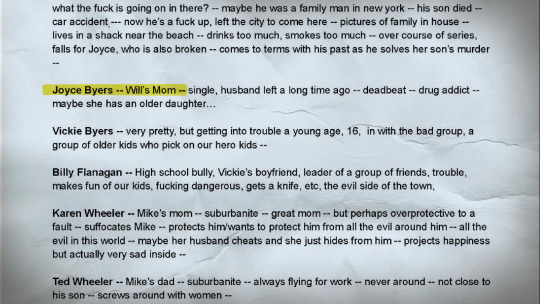
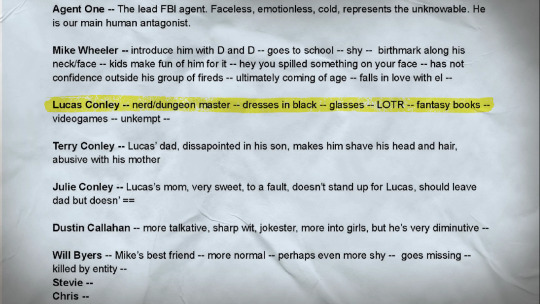
The Duffers then explain how a lot of it “mostly stuck”, how some stuff didn’t make it into the show, and then we have characters whose name changed but their purpose stayed the same, or those who got some traits swapped up with a different character. For example, how the “Billy Flanagan” role was first represented by Steve back in S1, and later on by Billy, even with the same name.
I’ll talk about a few characters, their old traits vs what I think (based on the show) they ended up changing.
Karen Wheeler: She's first described as a great, overprotective mom, who suffocates Mike and tries to protect him from the evil around him. She hides from his husband. Projects happiness but actually very sad inside. This obviously didn’t stick. This sounds an awful lot like Joyce, word for word. See, instead: Julie Conley. We’ll get to that in a bit.
Ted Wheeler: Suburban, always busy with work, never around and not close to his son. This is still pretty spot on. Ted Wheeler was always meant to be exactly who he is. But wait, could there be more to it?
Mike Wheeler: --introduce him with DnD-- shy, birthmark on his face and neck, which he is bullied for. No confidence outside his friend group. Ultimately coming of age, falls in love with El. Mike’s connection with DnD and being bullied stayed. The rest, however? it all changed. Notice how Karen used to have a role more similar to what ended up becoming Joyce. Now, look at Mike’s first description. Sounds familiar, right? That’s because it basically describes our Will: shy, with an overprotective mom, no confidence outside his friend group and with the ultimately coming of age. Falls in love with El Mike. I’ll get back to Will in a bit, for now, let’s go back to Mike. The Duffers also mention how his character completely changed and it was influenced by Finn Wolfhard’s performance: the Mike we know isn’t shy, quite the opposite! he’s brave and fills up the group leader’s role.
What does this mean? It means his character arc can’t stay the same, because his fundamental traits, those that define him as a character and give him a drive, also changed. See one of Will Byer’s previous descriptions: More normal. Rings any bell?:)
Lucas Conley: Nerd, dungeon master, dresses in black, glasses, LOTR and other fantasy books, videogames, unkempt. As the Duffers say themselves: this is nothing like our Lucas Sinclair. Instead, it sounds more like…

You guessed it, Mike! With his Hellfire t-shirt, long hair, more edgy look and interest in videogames and fantasy. This is not the only reason why I think Mike ended up filling this character’s role. Just wait until you read the next ones.
Terry Conley: Lucas' dad, disappointed in his son, makes him shave his head and hair, abusive with his mother. Very obviously not our Lucas’ dad. Instead, it’s a mix of both Ted (disappointed) AND Lonnie (disappointed and also abusive). Why do I include Ted, when you could arguably say he’s not disappointed, just never there emotionally? Because of the hair thing and his wife’s description. By saying he makes his son shave his head and hair, it’s implied that it’s because it’s long/not “normal”, or “adequate” enough. Ted Wheeler is an absent father, but he also represents conformity and traditional values: he would not support his son’s hairstyle choices.
Julie Conley: Lucas's mom, very sweet, doesn't stand up for Lucas, should leave dad but doesn't. Again, not our Lucas’s mom. This is word for word the Karen Wheeler we know: sweet but doesn’t really stand up for her kids. Should leave Ted (see: the almost-cheating plot and their unhappy marriage), but doesn’t.
This is the family that’s meant to represent normalcy, conformity and traditional values, but they happen to have a rebellious son. THIS is the role that the Wheelers ended up filling, you see it very clearly from the very start with Nancy, a little bit with Mike (who then retreats, trying to fill his expected role) and we start seeing a glimpse of rebellious Mike again in s4.
Will Byers: Mike’s best friend, more normal, more shy, goes missing, killed by an entity. He doesn’t have much of a description, but besides going missing, two traits stay: Mike’s best friend, and shy. As I mentioned when I talked about Mike, since his traits changed, so did his character arc. He’s still the shy, missing kid that drives the show, defined partly by this experience and the events that revolve about it. We just have to add the missing pieces to it: (see: Mike Wheeler’s original description) lacks confidence outside of friendgroup. Overprotective mother. Tied with DnD. Bullied. Ultimately coming of age. Falls in love with El Mike.
Need more convincing, more proof? Let’s take a look at this section of the show’s bible.
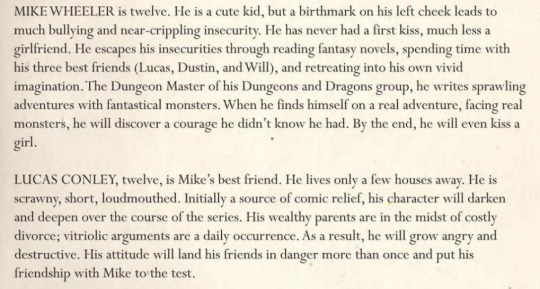
Now again, with my notes. The yellow highlighter represents what is true to Will’s character, and the blue one represents Mike (yeah, I know, I know).

“He’s never had a first kiss, much less a girlfriend. [...] he will discover a courage he didn’t know he had. By the end, he will even kiss a girl.” This was meant to be Mike’s original character arc. You COULD argue that it’s only about season 1, but even then, it is not true to the events of the show. Mike’s s1 story was NEVER about his insecurities with girls, not having a girlfriend, and finding courage. The entirety of Mike’s actions in s1 (and therefore, his arc) are driven by Will’s disappearance and the goal of FINDING him. It’s NEVER, not even once, not even when other characters try to convince him of it, getting a girlfriend and kissing a girl, despite having kissed El by the end of s1.
Instead, whose plot is intrinsically TIED with romance and a confirmed coming-of-age story about finding courage within yourself?
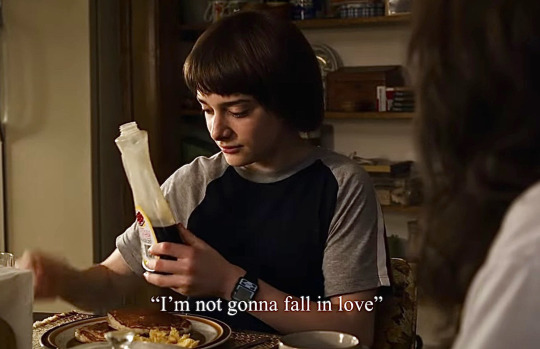
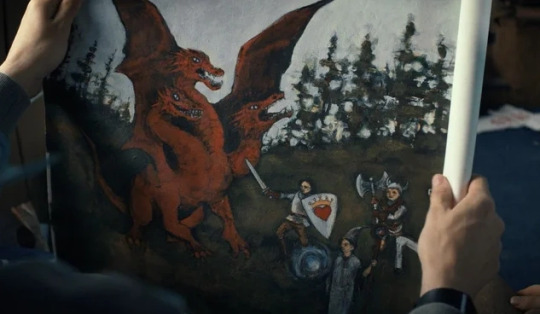
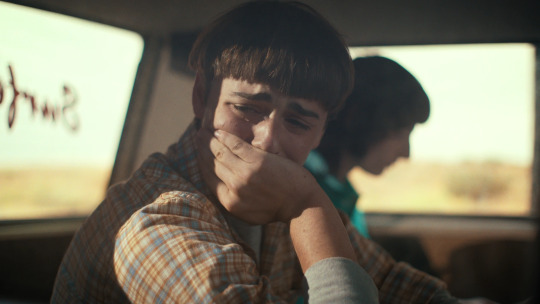
Yeah:) And you KNOW what’s the logical conclusion the Duffers have written for this particular arc? “By the end, he will even kiss a girl boy.” That’s the resolution to this kind of arc. NOT rejection. It is a pretty clear example of “Taking a character from point A to point B”.
The Duffers say: “you can’t give everyone an amazing, big arc. [...] We gave Mike the biggest arc in terms of him coming of age” and then explain how IMPORTANT it is to not try to explain everything all at once, instead, drop hints so you're telling the audience, "this is an important part of this character and we're going to continue to explore it, but we're just getting started you can't just include it all, reveal it all too soon”. You can’t make it too complex from the very beginning either, instead, simplify and slow down.
Then they mention how they like to take a character that's a stereotype, make the audience believe they know this character, make them believe it’s a comfortable portrayal, something they know. And then you flip it and reveal there's more to this character because no one can be so easily defined. However, just HINT it. The reveal will happen on its own, at the right time for the story.
So, based on all of this… What do I think that happened?
This might be an unpopular opinion, but I do not think they planned byler from the very start. I think they had an idea of what they wanted to do, of what message they wanted the show to send, but found out along the way a different, more natural, and groundbreaking way to accomplish that. And I think they realized as soon as early s1, when they knew they wanted it to become a several seasons show rather than a limited series. It’s no coincidence there are elements like Will’s sexuality, homophobia, and conformity present from the very beginning. But they also found a way to portray this in a subtle way so it made sense in both outcomes: if they didn’t get a s2, s1 could still stand on its own, make sense, and feel resolved enough. If they got more seasons, they had more time to hint at this story, get the greenlight, and develop it over the course of all the seasons.
I also think the characters themselves, despite being written by them, lead them to this conclusion naturally. As they say in their masterclass…

“You can drive and throw obstacles at them, but they can become very real, and sometimes they end up doing their own thing, surprising you”.
To finish this analysis, let’s do a little exercise.
What is Mike’s Overall Arc, considering the following?
His family represents conformity, an upper-middle-class household that’s apparently normal and very traditional.
Both Nancy and Mike are meant to be the Rebellious Children in their very normal, traditional family.
Mike goes from leader to comic relief, to the Angry-closed off-messes-up character archetype. This is so evident that he even becomes unlikeable to most of the General Audience.
The Duffers remind us that hints are important and addressed later. Seemingly ‘weird’ actions and off personality have an explanation: there’s something deeper going on with Mike. You cannot address it all at once, it has to be over the course of episodes and seasons.
More advice from the writers: sometimes you plan something but end up realizing it works out better in a different way. Sometimes your own characters surprise you, and take you to the path that is more natural for them, who they are, and their story.
Mike’s character arc was never getting the girl once the Duffers really established who Mike was.
And with that, I conclude this analysis. :) Wait for the next one! Please tell me your thoughts if you liked this and read this far. I love reading your tags and comments.
#byler#mike wheeler#will byers#stranger things#st analysis#anti mileven#my analysis#mike wheeler is gay#i don’t like begging for reblogs and notes#but i’m really proud of this one and spend an insane amount of time on it#so just this once i’m on my knees begging#if u liked it pls share it and tell me ur thoughts……#seeing that people are interested in my analysis is what keeps me going and reminds me i’m not alone in this
134 notes
·
View notes
Note
she sang these surprise songs to distract us from how bad the Karma MV is.... Jk, she looks hot and all and the devil scene is a serve but i am getting sooo tired of the cgi onslaught and the "random scenes of me looking cool" kind of concepts. I gettt the theme whatever but girl none of it is fun or interesting! Ari caused a stir with a similar mv concept a few years ago already!!! You waxed on and on about being a film nerd a while ago WHERE is that? And I knooow music videos are a different wheelhouse but you can do so many cool things with them and in the past Taylor has had amazing storytelling concepts and cool visuals and from like Lover onward it was like: "Teehehe look how many Easter Eggs I can drop in these 50 unrelated scenes filmed in front of a green screen". The fucking art heist music video she filmed in Liverpool better be good.... I am tired... (Sorry for being mean and rambling in your inbox it's just. Blergh!)
i totally agree and i'm not really a current mv aficionado (ask me about any mv from the 90s thru the mid 2010s tho i gotchu) but i can speak to how the cgi garbage onslaught is saturating film as well and it's soul sucking. look i get it that cgi is cheaper than it's ever been before and practical effects but so many "directors" use it as a crutch. it's just plain ugly for the most part and you can compare the practical effects in the LavHaze video and see how lovely and gorgeous and tactile something can be when done practically. it's just more tangible and quite frankly show's a level of skill and understanding of the medium and craft of filmmaking where cgi just shows the opposite. it's not going away, unfortunately, but there are still many directors out there who insist on practical or use cgi in really tasteful ways.
i also think many swifties don't want to reckon with this but she is a budding filmmaker (if she continues on this path) like she is JUST STARTING. which means she has no skills in this department. her mv's prior were amazing because they're made by longtime professional directors. and i don't care how good you are at storytelling in other mediums, filmmaking is a very specific and restrictive way of doing it. and if you're bad at it, it's VERY obvious, and it's like learning a new language. yeah you can write a stunning novel in english, but it'll take you at least 10 years to learn spanish competently enough to even attempt to write a novel in spanish that is as deft and skilled as your english one, and it will probably still not measure up. because a language is more than the words; it's also the phrases and the references and, well, you get the metaphor. creative skills take decades to hone. unless you're a savant, or someone with a singular, culture shifting vision (which she is not, not in film at least, sorry) it takes soooooo many films to really sharpen your tools and understand the craft. i'm willing to give her some slack in that department, as every MV she makes is just basically her film school projects, and film school projects are clunky and middling at best cuz you're learning. sometimes i like them, and sometimes i feel like they're just not quite there, but she's fortunate that she is afforded this many mini projects to experiment and find her footing before embarking on a feature. unfortunately they are also promotional material, so they must be bogged down with easter eggs and the like. i'm sympathetic to that, even tho i am, like you, also frustrated. I really hope the liverpool one is good. it looks like it had a lot of moving parts which is promising!! hopefully less green screen cop out garbage. fingers crossed!
7 notes
·
View notes
Text
I Am YEG Arts: Heather Shillinglaw

Mixed media artist Heather Shillinglaw expresses her Indigeneity and familial oral histories through collages that employ sewing, painting, and sculpture methods. She grew up in Ministik near Cooking Lake and now lives in Edmonton and has a strong connection to the land and to her heritage; Nêhiyawêwin /Cree, Dene/Chipewyan, Salteaux/Ojibwe, and Scots/French. Over the course of her career, she has shared land-based teachings in art workshops with thousands of students of all ages, taken on activist work to highlight the importance of the natural world to inspire others to preserve what is left, and has exhibited her work extensively. In this week’s I Am YEG Arts feature, we get to know more about Heather Shillinglaw.
Tell us about your connection to Edmonton and why you've decided to make it your home.
Growing up outside of Edmonton, we would come into town to do our shopping, and all that kind of stuff. And I always thought it was so fancy, and a fantastic place to live with all these great shops and beautiful river valley to pick berries or whatever. It maintained a consistent interest for me to live here and settle here. Now that I have my family, my husband and my two daughters, we call it home. And it's not far from the place where I grew up, and my family. So, we're kind of surrounded within Edmonton. I also have an ancestral connection to the land in that they harvested medicines, mostly berries here, which I'm very glad to say that saskatoons grow prevalently in our River Valley.
What is your creative process like? And what motivates you as an artist?
I started out mostly as a mixed media artist, project based, so when I make art, I'm very material based. There's kind of a relationship with the material that I start building a language within the work I'm creating. It's either through symbolism, the materials, or the project base -- the goal -- which is talking about the environment, preservation of what's left, to creation of the piece itself. Right now, I'm obsessed with sewing, and I'm sewing on hides and then I'm sewing on big florals. I collect and harvest like a mouse. That's my animal spirit and I see things large and giant, and I'm very humbled by the land.
In my pieces I’m using anywhere from three to six different types of sewing machines to create the work. When I'm sewing, I'm thinking about that kinship and relationship to the landscapes, like the maternal landscapes. It's all nature based and it's all about the healing plants and medicines that are in our land.
How do you choose the materials you work with?
That's a tricky one because I'm constantly collecting like a mouse. Another aspect in thinking about conservation of our land and not causing problems, I use a lot of recycled materials and mediums. In the body of work that I'm still creating, ᒫᒥᑐᓀᔨᐦᒋᑲᐣ ᑯᑖᐄᐧᐤ mâmitonêyihcikan kotâwîw, – my mind digs in the soil like a turtle -- an exhibition that's happening right now in Halifax at the Mary Black Gallery -- I'm sewing on to hides and it's kind of an eagle eye’s perspective. Through that I'm doing tufting, beading, and sewing into bodies of water that relate to the landscapes of where my ancestors hunted and harvested. Inspiration sources come from here, there and everywhere. So, you know, I'm a mouse that acts like a magpie.

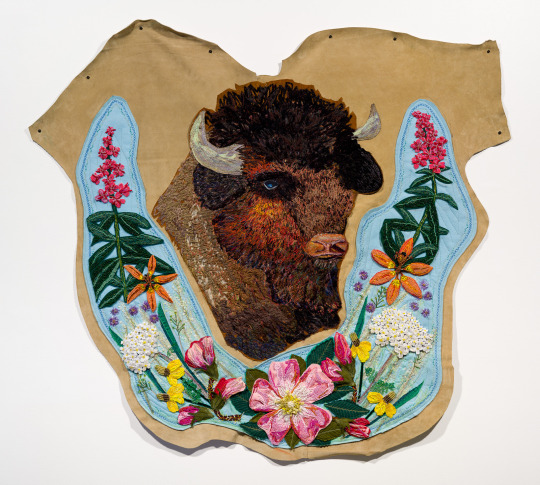
Top: Detail of ᑮᓯᑌᐳᐃᐧᐣ ᓵᑳᐦᐃᑲᐣ kîsitêpowin sâkâhikan cooking lake by Heather Shillinglaw. Bottom: Gravemarker Bison from the Whiskey Script Series by Heather Shillinglaw.
Where does your inspiration come from?
The inspiration comes from the land itself. For a lot of my projects, my inspiration source is my mother: through storytelling about the land, and her memories from our Nohkums, our grandmothers, and how they harvested from the land, right down to the specific berries, or the relationship that the moths share with the trees and how it provides a kinship relationship to the land itself. Then through that, I'm taking oral stories and I'm also looking at other forms of research, such as archival research. I've worked with ethnographer Ruth McConnell and I've been working with Elder and Knowledge Keeper Lynn Desjalais/Lush from the Sandy Bay Reserve (she's a relative of ours, I think that's an added bonus). And Anne Cardinal, who's from Saddle Lake Reserve. There's a cultural connection, an artistic connection, a research base. So, there's many different platforms in my resources and where I make my art from.
Marilyn Dumont is another source of inspiration. Marilyn is a Métis poet, and we share common lineages in where our inspiration sources come from. I've been sewing her poetry into bodies of water, and I sew my own poetry now because she's given me a lot of strength to do that. So that's another aspect of my work – using poetry and prose to talk about what's going on in the art. I'm so honoured that she said she's willing to work with me and we continue to work together on projects.
You've had the opportunity to exhibit your work nationally and internationally as well as participate in residencies abroad in Paraguay and Argentina. How was your artistic practice influenced by these cultural exchanges and how was your work received?
That was so much fun. 2009 was a bit of a banner year for me. Beatriz Ventura , who is the Canadian consulate located in Buenos Aires, for Argentina and Paraguay, connected with me and we talked about medicines, and she talked about her ancestors and how they hunted and harvested. Through that I sat on panel discussions, I exhibited my work, and then I did a little bit of a residency. I was quite excited and engaged by what was happening with the Indigenous people out there and how it was almost like going back 200 years for their discovery of the oil rights in the land. I gave some advice, from my ancestors and their trauma and problems that we've had in the past. I got invited to go around with an anthropologist in Mendoza and she took me up into the mountains, and we met the Indigenous tribes there. It was a phenomenal experience.
The more I thought about it, the more I wanted to talk about plant sustainability, which is in my practice today. Then I got invited by a conference attendee from Paraguay, Asunción to stay in her home. I got a chance to meet all these wonderful people there, networked with them, created workshops for the conference that I attended, gave a panel discussion presentation of my work, and then I also got a chance to work with the UNICEF school out there as well. I kind of became a little bit of a political activist. I'm not in your face in my politics; there are political statements within the art itself. And the more I create my work, the more I'm concerned about the land and preservation, because our oil and gas industry is affecting our water tables, it's in our system and there's some relationships of what Industry Canada is doing to our land that is very disconcerting. As an artist, your job and your role is to make sure you carry your message through your art, so that's where art becomes an activist statement. And I don't want to be in your face. I want people to want to understand. And that's where you can access more of a deeper, profound way of understanding the art, understanding culture, and understanding our planet and preservation.


Top: Gravemarker Fox from the Whiskey Script Series by Heather Shillinglaw. Bottom: Painted Red by Heather Shillinglaw.
What would you say is your greatest strength as a creative?
I have taught many artists and residencies over the years, and I worked at the Art Gallery of St Albert as their first Indigenous Visual Arts Programmer; I take pride in that. Whenever I'm teaching, I take it upon myself to inspire people. That’s important and supports my practice. That's another hat that I wear as an artist. Through my Elders, I've learned that a big part of our culture is sharing, and you share with humility. Like, the information that was given to me, you hand it down for the next generation to inspire them. And they're probably not going to make the same work that you're going to make; the goal is to inspire, and that’s why I teach.
Tell us a little bit about what you're currently working on or hoping to explore next.
At the Centre of Contemporary Craft of Nova Scotia there is an exhibition of my work right now, it closes on July 2nd. I will be going to see the exhibit and attend a series of things going on out there. It’s a body of work called ᒫᒥᑐᓀᔨᐦᒋᑲᐣ ᑯᑖᐄᐧᐤ mâmitonêyihcikan kotâwîw, – my mind digs in the soil like a turtle, and it's basically large landscapes and a body of work that showed here last year at the Alberta Craft Council. It does come back here in the fall, in September and October at the Art Gallery of St Albert. We're going to be doing some exciting activities, workshops and talks.
In January, I have an exhibition at the McMullen gallery. I'm going to be doing some workshops and artist talks and events. And as a sneak peek, for Gaagige Giizhig - Ishpeming (Forever Sky) (the Sky Above) I'm going to be turning the gallery to space! Those are works are on black panels, and there's thirteen of them, and they're not small either -- some of those panels are larger than me, so maybe like 8' x 5’ ft. MSHKAWJI GIIZIS (FREEZING MOON) – OCTOBER for example, is one of them, it’s the frost moon, so they're really different.
And then I have another body of work, it's called Whispers in the Forest, and it's going to the Esplanade Gallery [in Medicine Hat]. It's part of a larger group exhibition. In 2026, I have a solo exhibition at the same gallery and I'm just working through that. I'm going to be focusing on learning ancestral languages from language keepers: Saulteaux Denesuline language, Anishinaabe language, and Nêhiyawêwin Cree. It's going to be a massive mouse trap, a life-size mouse trap that focuses on live, eat, sleep, repeat.

Detail of MNIDO GIIZIS (SPIRIT MOON) – JANUARY by Heather Shillinglaw.
Tell us about a local artist group or organization that is doing great work in the community that you think more people should know about.
I would start off by saying CARFAC Alberta is fantastic and great to work with because they do a lot of programming to help artists survive as artists. There's a lot of versatility in the art world, but it's challenging to survive as an artist. They do all kinds of workshops to help people, anywhere from writing grants, to what's next, or how to ship your art internationally and that sort of thing. So, there's lots of opportunities for artists to learn from them.
And then I would say the Art Gallery of Alberta is fantastic. I’ve shown my work there, I sell my work at the art rental sales, and I've had opportunities to work with them and be a special guest artist, teaching workshops for them that a benefactor had paid for. There are phenomenal opportunities for artists to connect with them. Outside of that, there is the Art Gallery of St Albert. Emily Baker and Leah Louden are fantastic. They also sell my work out there, and they do amazing programming that is so unique. You can go in by donation and still access a lot of the arts just in that space itself. So those are some really good places that do so much in the community.
The Rowles and Company Gallery also sells my work. I'm saying support our local galleries because you know, they really struggled to get through COVID, so it's really important to share that message with others.
And I didn't even mention the Edmonton Arts Council, that they offer so much programming, so many grants and possibilities for artists themselves. I've been honored to be a recipient of those grants and organizations for money to create my works.
I am also so thankful that I have been inspired by Shirley Norris Shillinglaw, who's my mother, and my family that supports me. Keith Macmillan and my daughters tolerate bits of thread and my messy nature. They’ve been very generous to allow me to do that.
About Heather Shillinglaw
Heather Shillinglaw is a project-based artist adapting art materials using sewing, painting and sculpture methods. Growing up in Ministik near Cooking Lake, she now lives in Edmonton, Alberta. Shillinglaw is proud of her heritage; Nêhiyawêwin /Cree, Dene/Chipewyan, Salteaux/Ojibwe, and Scots/French. Shillinglaw shares land-based teachings in art workshops to thousands of students of all ages, throughout her career. She becomes an activist, her voice in sharing through art she hopes to inspire the importance of the natural world to inspire preserving what is left. Exhibiting her work nationally and internationally, she is humble in acknowledging the awards and Grants that help her projects, inclusive of a recent award Leighton Studio stay at the Banff Center for the Arts; the Gerin-Lajoie Studio. Previous exchanges abroad in Paraguay and Argentina working with anthropologists, medicine women of Tobian- Guarani and Mapuche healers in South America, and other shows/cultural connections abroad. You can learn more about Heather here.
3 notes
·
View notes
Text
TV Shows - 3 Body Problem VII
Episode five is my favorite, and for many reasons.

For those who don’t know, I’m quite fascinated by Sophon and her German voice actress, Sophie Rogall. When Wade and Jin manage to decode the Judgment Day data disc, they enter the virtual reality of the game and are greeted by Sophon. She explains why all these things are happening, especially in science. This explanation still fascinates me, even though it’s been quite a while since I first heard and saw it. The idea of protons being unfolded into higher dimensions to become an oversized computer—who comes up with something like that?
But now I’m wondering if it actually makes sense. I don’t mean scientifically, but rather within the book's universe. I need to think about it more and maybe read up on it, because later on, the concept of dimensions comes up a lot, and I’m not sure if there might be some contradictions.
However, the San-Ti world isn’t the only fascinating part; Auggie on Earth also has a lot to deal with. Her nanofibers are used in a massacre, and I find it very interesting that she’s not portrayed as being indifferent to it. Even at the beginning, before Judgment Day arrives, she starts to have doubts. Later, we see how she actually breaks down because of her actions. I think this is a very realistic portrayal, and I appreciate it because it shows a lot of humanity.
Something I just noticed is that the Judgment Day data disc is the same color and shape as the red book carried by the protesters and revolutionaries at the beginning of the first episode. Could this be a symbol of a failed revolution, or some subtle foreshadowing of what's to come?
Back to Sophon’s explanation of how the San-Ti plan to remain superior to humanity. The entire explanation is incredibly creative and interesting, showing how well the author prepared and how detailed his storytelling is. I’ve mentioned before that many characters make decisions that have effects far into the future. This forward-thinking approach is a major aspect of the Wallfacer Project, which we only get to see near the end of the last episode.
This is what I meant in my last post when I said that the brakes are no longer on and things are speeding up rapidly. Will’s story is also picking up pace and will soon become much clearer.
At this point, or maybe one episode later, I wish they had already started with the Wallfacer storyline. Yes, I understand the dramatic choice made by the series creators, but if they had started it earlier, it would make more sense by the end. In the book, you’re also thrown off at first, but then things are explained more, so it all makes more sense. I’m very curious to see if the Wallfacers will make the same proposals, if there will be Wallbreakers, and how it will all develop.
With every post, a thousand thoughts come to mind about how things will be portrayed, and I find it so exciting. I’ve mentioned this many times, so please forgive me. But let me explain! I’m a big fan of Isaac Asimov, have read many of his early books, and I like how he often critiques society. Many of his ideas are still relevant today. I’d put Liu Cixin on the same level as Asimov. He fascinates me just as much, brings up similar societal critiques, and captivates me because I’ve read a lot from other authors, but most of it I found quite boring (maybe I should write about authors I like—let’s see!). But yes, that’s one of the reasons for my fascination. I’ve found something that captivates me with its complexity, its imagined scale, its style of science fiction, and its societal aspects.
#3 body problem#trisolaris#netflix#tvshow#rewatch#tv show#remembrance of earth's past#jess hong#benedict wong#Eiza González#netflix series#netflix shows
1 note
·
View note
Photo

Iris van Herpen's Underwater Film Is Her Most Personal Message Yet "Feminine empowerment has been part of my work for a long time, but I don't think I've expressed it this fiercely before," the designer Iris van Herpen tells me over Zoom, just a few days before her short fashion film (yes it's actually short, just four minutes) debuted in time for the haute couture shows in Paris.For the past few months, van Herpen has been contemplating on the state of the world for women, particularly in places like Iran where women's bodies have served as a battlefield for ideology and authority. Film was the best medium for her to explore these ideas of female bravery and perseverance.Related | Tsunaina on Merging Her Dreamy World With Iris van HerpenShe teamed up with French artist and director Julie Gautier on the film, called Carte Blanche, a dreamy visual showing models in motion underwater at various depths in their couture dresses (only seven looks were made this season). The use of water is a symbolism of female shapes subdued and slowly disembodying control — movements tell a story of resistance and finding freedom.“In the beginning three woman are melted together into a painting of skin, textures of growth and decay," read the show notes. "The red heart of this female ocean drifts down alone into the deep depths of her own consciousness where she dances a journey of isolation and oppression moving into resilience and invincibility.”Below, van Herpen breaks down the meaning of the film, the underwater symbolism and the important of remaining independent.You've experimented with various formats before, so why did you to decide to go with the video route this season?The concept is really about feminine empowerment and also some current issues that are going on. One is the demonstrations in Iran, which is a subject that I've been following closely and bringing this into the production felt very important. It felt better to go for a film this time and to have the creative freedom and the storytelling to really go deep into the concept.When did you connect with Julie, the artist? Had you guys known each other already before this project?No, we haven't. I knew her work for a while and she knew mine. I've been following her for a few years, and the first time I saw her work was the film called Emma. But then I also saw A Breath Around The World, which is a beautiful film that she made with her partner and she really embodies female strength to me.So when I was working on this concept, and the beginning of the collection, I started the conversation with her to see if she was interested in working together. So, we've really been developing the storyline and the choreography and everything together.The pieces in this collection moved so gracefully and fluid in the water. Did you think about that at all when designing and how the collection would translate into this underwater setting? Or did that come after you designed the collection?We thought about it all the way through. In our early stage, we decided to go for this film and to go for the underwater exploration, so this was really part of the development of the collection. I wanted the garments to move beautifully and to look beautifully above water, but also underwater. And that was the challenge because gravity and movement is so different underwater, that sometimes we had a fabric or a texture that moves really beautifully underwater, but then it didn't look that good above.So, it was constantly the balance of finding the right materials for both, because after the film, we also want the garments to be worn. That was the development that took the longest, to really have it work in both worlds.Speaking of what's been going on in the world and places like Iran and this idea of the female body and bravery ... why was that important to you as a woman and designer observing everything?Well, on a very personal level, I've been a woman myself working in the industry that is still quite a male dominated. If you think of the creative directors with the brands ... I of course have had, and still have, my own struggles in that.In every place this balance is different. I've been quite fortunate in where I grew up in the Netherlands, where it's quite equal, even though there are differences here, I realize that what's going on in Iran is not a local issue, it's a global one. And of course it's in its extremities there.And I also realized that it changed my perspective to beauty because I've always seen beauty as a very powerful and positive strength. But looking at what's happening there, I realized it can also be a tool that is misused, or a tool to oppress.I want to bring these elements into the work to show the control and the oppression that is going on and medium of beauty as a very personal tool to express who you are and your own identity and to find strengths to carry on the conversation and the focus towards this issue.As an independent designer yourself at this stage of your career you're still following your own rules. How happy are you just getting to do what you do at your own pace?Freedom is an important part of everything that I do and my decisions I have taken are all based on that. I am still independent and that was really important for me because that independence creates complete freedom in what I create, in the way I create. It's that freedom that is really core to the designs, and I think they radiate that freedom.I think when you look at the work, you can tell this is not like... I don't know, a commercial team deciding what direction to take or too many people involved. It's quite pure and that has been very important for me because it's to me, the way that I can distinguish the work from all of the rest. I think people can recognize the work therefore, and tell the difference.Feminine empowerment has been part of my work for longer period, but I don't think I've expressed it this fiercely before. And that is really a reaction to the world around me and realizing that we really need to support each other to all have more freedom. The element of freedom is so important to me, but this is also what made me dare to go into design, to have the courage to go this freely into the work.And throughout the years, many people have tried to steer me, and I think my stubbornness is really part of who I am, but also part of the designs. Photo courtesy of Iris van Herpen https://www.papermag.com/iris-van-herpen-spring-2023-2659296487.html
0 notes
Text
🦜Astrology Observations Pt.4🦜
Collaboration with @venusfun 🌈
Huge thanks to my wonderful bestie @venusfun for sharing an amount of observations in this astro notes and helping me with the overall view of this post. Also please check her out if you don't know her yet, she creates a lot of spectacular astrology posts and you can learn a lot about asteroids from her blog❤️🧡💛💚💙💜

Part 1. Asteroids
🌈According to research, asteroid Angel(11911) was first discovered when it was still under the sign of Sagittarius
🌈Having your asteroid DNA(55555) in an earth sign can indicate that your children may see you as someone who is grounded, hard working, practical, and very stubborn. They might look up to you because you are capable enough of giving them the best life you could give and they would understand that your hard-work is a way to support the family
🌈Asteroid Psyche(16) in Pisces/Libra craves romance that is fanstasy-like, something out of this world or something magical that just came out of a romantic story. These folks are the types of people who might be actively looking for true love
🌈Vesta in the 7th house might prefer to not get married
🌈People with Psyche(16) conjunct mercury think on the “soul” level (with heart)
🌈Prominent Ceres can indicate being a very loving and supportive mother but if Ceres have many challenging aspects then it can be obsessing
🌈Diana(78) in an aspect with MC(midheaven) can indicate work with animals
🌈Sirene(1009) in 2nd house indicates beautiful voice
Part 2. MBTI & Astrology
Sidenote: There's no correlation between MBTI and Astrology and we are using this only for personality observations
🌈Cancer/Moon dominants fit with the stereotypes of ISFJ. Both are maternal, nurturing, supportive, sympathetic, selfless, always protects their loved ones, and are sick of dealing your shit lmao. Also they tend to be the Mom/Dad of their friend group and the ones who always brings food 😋😋
🌈 I noticed most Sagittarius placements tend be ENFPs or INFPs base on MBTI. Maybe because both are idealistic, goofy, huge procrastinators, creative, and free-spirited. This can also apply to Jupiter/Pisces dominants (For Pisces it's more on INFP)
🌈While Virgo placements are more fitting with ISTJ because they are dutiful, loyal, traditional, organized, reliable, practical, and fact-minded. And with ISTJs dominant cognitive function which is Si(introverted sensing) they can use the past as a guide and lesson to be used in the present which explains them relying on the tried and true methods in dealing things
🌈In my own opinion, Scorpio/Pluto dominant just gives me INTJ vibes. Maybe because of their analytical and reserved nature
🌈Since the earth signs are known for being observant and detail-oriented, they are more of a sensing type because sensors can notice every single detail of a certain thing such as noticing that you change your hairstyle or you changed your signature perfume and they can sometimes miss the bigger picture. Also sensing types are more focused on the present(Extraverted sensing) or in the past(Introverted sensing) rather than the future which fits the earth signs who are more focused on experiencing the physical world
Part 3. Composites
🌈Uranus in the 1st can indicate that people might perceive you two as best friends
🌈Neptune in the 1st can indicate that people might see the partners as very spiritual and "usually not seen around" relationship
🌈Pluto in the 1st can indicate that people might project you two as very intense and "deep" relationship
🌈Sagittarius ascendant in the composite chart will indicate that other people see the relationship as very fun and adventurous. It has a philosophical vibe
🌈Earth Ascendant in a composite chart can indicate the relationship as stable or grounded and loyalty is established
🌈Uranus in the 3rd can show that two of you may have some odd ways of conversing with each other or have an unusual way of expressing things that only the two of you can understand
Part 4. Degrees
🌈People with 8th degree on a personal planet (Sun, Moon, Mercury, Mars, Venus) can find success easily, especially when it comes to business. But if a person has at least three 8th degrees, then the individual can be very materialistic and is only “money-oriented"
🌈Having a good amount of Pisces degree(12°, 24°) in your chart can indicate that you are good or capable enough in balancing your fixation between reality and fantasy but having a lot of it can indicate of you having tendencies of escaping reality and isolating yourself from everyone
🌈Even if your placements are full of feminine/introverted signs(earth/water), if you have a lot of fire/air degrees in your chart especially in personal planets or in your ascendant, you may be more sociable and outgoing. This goes vice versa as well
🌈People with a lot of 5 degrees (at least 3) are actually passionate about going to the gym. A lot of athletes have this degree
🌈Having a Virgo/Scorpio degree(6°, 8°, 18°, 20°)in your personal planet can indicate someone who tends to question anything especially out of either curiosity or suspicion, these people need to be sure that you are trustworthy(they might find ways to trick you or manipulate the conversation to see if what you are saying is true)
Part 5. Random
🌈The house where Leo is in is where you are mostly loved for:
Example:
10H Leo = admired by your ambition and your organizational skills,
11H Leo = admired by how you make friends easily and your networking skills
5H Leo = admired by your passion towards your interests or hobby,
3H Leo = admired by your communication or verbal skills,
2H Leo = admired by your voice and how you handle your finances
🌈Water/Moon/Venus dominant 🤝 Can easily connect to music and would be dancing in their own room till someone enters in
🌈Fixed Moon/Venus/Rising are the types of people who when they find a good music, they would replay it endlessly till they are good enough to stop and feel contented already from listening to it
🌈October Scorpios tend to be more outgoing, sociable, and hot-tempered than November Scorpios but this doesn't change the fact both can be mysteriously alluring and are really intense individuals
🌈Pisces with a mix of Scorpio placements tend to have this dreamlike presence and looks. It's like their physical appearance are just oozing a dreamy yet mysterious vibes
Example: Jungwoo from NCT Pisces Sun + Scorpio Moon

🌈Since the 9th house is the house that associates with religion, it also symbolizes the church and God
🌈The last 4 astrological signs in the zodiac wheel(♐︎ ♑︎ ♒︎ ♓︎)are known as the universal signs, these signs are mainly focused on the outer perspectives of life and are less focused with the self and their relationships. Sagittarius is focused on other cultures, religion, and their own opinion towards things, Capricorn is focused on the understanding of our physical self and the underlying achievements of one's hard work, Aquarius is focused on principles and humanity, and Pisces is focused on the spiritual aspects of life and the connection with the infinite universe
🌈Neptune in 1H/5H/9H/12H/Neptune dominant gives me a feeling like they belong during the renaissance era where philosophy and arts was at its highest peak, these folks tend to be abstract, artistic, and philosophical
🌈Mars in Cancer/Taurus/Libra are mostly seen as people who are very laid-back and many underestimate them base on their energy due to Mars being in detriment/fall with these specific signs
🌈Many people agrees that Geminis are great storytellers but no one talks about Virgos being good at story-telling as well. Both are ruled by mercury and they tend to have great ideas or stories that they can share and express with
🌈Pisces/Aquarius/Sagittarius Rising are the types of people who would wander around the mall(or a public place in general) and accidentally separates from their friends or family and gets lost
Damn, this was a long ass ride 😅😅 hope you guys enjoyed this astrology observations made by me, @leolo404 and @venusfun ❤️🧡💛💚💙💜
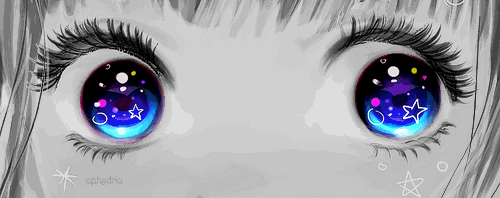
#astrology observations#astrology#astro notes#astrology post#horoscope#zodiac signs#aries#taurus#gemini#cancer#leo#virgo#libra#scorpio#sagittarius#capricorn#aquarius#pisces#nct#nct jungwoo#observations#degrees#composites#MBTI#mbti personalities#asteroids
2K notes
·
View notes
Note
Hey :) I have these headcanons that all of the golden trio had these passions and talents when they were kids that just went completely un-nurtured by their parents. Like, Ken was really into music and singing, Rome was a writer, really creative stuff. But they got kind of pummelled into business by their dad. And Shiv was into politics, loved it, and Logan’s neglect due to her being a girl is what allowed her to run with it into a career. Am I crazy? I guess this is a long way of saying, hey, I headcanon Ken still knows piano but would never dare admit it. What do you think their passions were?
Hey! Oh gosh, that's so cute, anon, I don't think you're crazy at all. I love the way the show touches on these genuine interests for all of them and then how easily they get swallowed, crushed or redirected by their father.
I was actually thinking about something along the same lines the other day with Connor and about how his mother ran the dance charity, and about what that means in terms of him being so encouraging of Willa's playwrighting. I like to think that maybe Connor's experiences and interests were shaped by both parents and are his way of connecting with them. It makes me thinks that his desire to change his mother's charity and move it away from the arts in s1 was about him trying to appeal to his father's nature and reject his mother to appease him, but his connection to his mum sort of spilt out in this way of encouraging Willa's creative work (even if it's bad, haha). Alan's said that he thinks Connor probably tried going to art school for a bit too which I love and kind of like to headcanon as maybe a trauma response after her death too.
As for the golden trio, I spoke a little bit about their hobbies in this post, but I'm especially loving your headcanon about Kendall being able to play the piano! I love the thought too that Shiv can play but doesn't like it at all? The parallels between Kendall and Shiv are some of my favourites on the show, and I love this idea of Caroline and Logan both wanting Shiv to learn how to play because that's what girls do, and her hating it but being forced into lessons for years and years while Kendall desperately wanted to learn but Logan wouldn't ever let him, because to him, it's a bit 'fruity'.
I like politics as a passion for Shiv, but I also like reading, which I talked about in my other post, and I think maybe something like debate? I can see her being in model UN and debate club in highschool before she realised that her dad would never come and see her thrive in either and so she sunk all her energy into horse riding and dressage and showjumping, because at least that was something her dad thought was appropriate (and liked the class connotations of).
And Roman I think is a natural born storyteller from the way that he lies so easily, hahaha. In a lot of ways I think maybe he had more opportunities to explore his passions at boarding school (especially since St Andrew's was no longer a military school when Roman would've gone there, although it was still very outdoorsy) and away from his father's constant influence, but I imagined that would've made the transition back to home during the holidays even harder. All freedoms were probably crushed in ways more brutal than Kendall and Shiv felt, because they never really left their place under their father's thumb, at least not until college. Given the camping and the fishing, and the fact that St. Andrews is such an outdoorsy school, I actually kind of like the thought that Roman likes being outside and that it's one of the things that was squashed?
On paper, it's the sort of 'masculine interest' that would appeal to Logan, but I think Logan has his own issues with that sort of thing because of Ewan, and I can see him projecting anger and the rejection of that onto Roman. I don't know though! What do you guys think?
#now i'm just daydreaming about the four of them going on a camping trip post-s3#haha#i love these four disasters#roy siblings#connor roy#roman roy#shiv roy#kendall roy#hbo succession#welcome to my ama#succession headcanons
40 notes
·
View notes
Text
Afrofuturism in the work of Janelle Monáe


Ashley Clarke, a curator for the Brooklyn Academy of Music, defined Afrofuturism as “the centering of the international black experience in alternate and imagined realities, whether fiction or documentary; past or present; science fiction or straight drama.”
Themes of Afrofuturism can be found throughout the works of Janelle Monáe. Her previous albums like The ArchAndroid and The Electric Lady showcase this through the exploration of androids as a new “other.” Today I want to talk about one of her most recent projects, Dirty Computer, and the way it contributes to the conversation on Afrofuturism. Janelle Monáe released Dirty Computer as an album and a 48 minute long Emotion Picture to draw her audience into a visual and auditory world of her own making. The dystopian future she presents to us is very similar to our own current reality, except that the voices being amplified are those that have historically been silenced. People of color and the LGBT+ community are central in this story rather than pushed off screen. Dirty Computer is so powerful because it focuses on joyful rebellion, love, and freedom in an oppressive dystopian setting.
The project, as Monáe has shared, can be split into three parts: Reckoning, Celebration, and Reclamation.
Part I: Reckoning
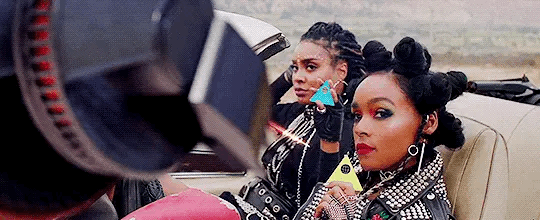
gif credit: scificinema
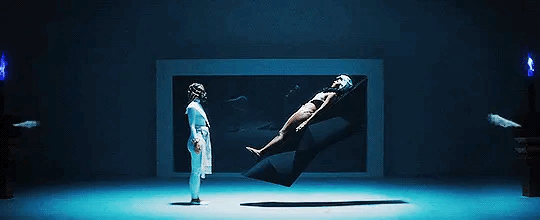
gif credit: scificinema
The Emotion Picture begins with Monáe’s character Jane 57821 laying out how her society has begun to capture people deemed dirty in order to “clean” them of their supposed filth against their will. This is meant to produce beings that are stripped of all individuality and ready to conform to societal norms and expectations. Jane tells the audience that, “You were dirty if you looked different, you were dirty if you refused to live the way they dictated, you were dirty if you showed any form of opposition at all. And if you were dirty it was only a matter of time.” The dichotomy between dirty and clean has created a system where an entire class of people can be demonized and oppressed. This foreboding tone at the beginning prepares the viewer for the grim implications of the cleaning process in this universe.
Dirty Computers are strapped to a table and forced to undergo the “Nevermind” which is a program that deletes memories. It is a process that is horrifying because of what it symbolizes to the individual and entire communities of people. To erase someone’s memories is to erase who a person is. The character of Mary Apple 53, Jane’s love interest, shows us just how alien a person can become once their memories are gone. The horror of erasure is also something that marginalized communities have faced for centuries and continue to face today.
In an interview on Dirty Computer, Janelle Monáe said “I felt a deeper responsibility to telling my story before it was erased. I think that there’s an erasure - of us, and if we don’t tell our stories they won’t get told. If we don’t show us we won’t get shown.” Afrofuturism is a response to this erasure of black people and people of color in culture, history, and art. Monáe has made a deliberate choice to tell her story even if it might get erased because if she doesn’t do it then no one else will. Remaining silent would be to assist in that erasure and Afrofuturism is all about refusing to be erased.
This first part of the Emotion Picture is all a reckoning with the Dirty Computers and how they are pushed to the margins. The lyrics in Crazy, Classic, Life speak about how the same mistake made by two people on different ends of the spectrum of social acceptability is punished unequally. Take A Byte follows it with a more upbeat tone, but even then the lyric “I’m not the kind of girl you take home to your mama” speaks to a feeling of being outside social norms.
There are moments of light and joy that are counterweights to the dire situation Jane is in. These come in the form of her memories which are played one final time before they are erased. Jane’s life before she was captured was filled with exploration, youth, love and celebration.
Part II: Celebration
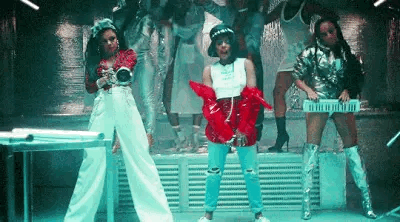
Gif credit: normreedus

Gif credit: daisyjazzridley
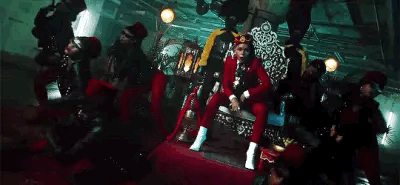
Gif credit: nerd4music
Dirty Computers seem to recognize that they are living on borrowed time and that any day could be the day they are forcefully disappeared. This is why they fill each moment with as much fun, life, color, and joy as they can. There are many scenes at clandestine parties where Dirty Computers live freely and openly despite the threat of drones or police that could capture them at any moment. It is important to have these scenes of celebration though because Afrofuturism is also about providing hope.
The future must be a hopeful one if we are to strive for it and Afrofuturism allows us to be creative in crafting our visions of a hopeful future. Even though Monáe’s future is dystopian, there is still room for hope and joy because those are the things that make life worth living. These Dirty Computers have to live their lives joyfully because they don’t know when they’ll be sterilized.
In the interview mentioned previously, Monáe added that “I had to make a decision with who I was comfortable pissing off and who I wanted to celebrate. And I chose who I wanted to celebrate, and that was the Dirty Computers.” The LGBT+ community, people of color, black women, immigrants, and low income people have all been mentioned as people Monáe wished to celebrate. This celebration comes intertwined with images and themes of rebellion as expressed in Jane’s memories. Screwed, Django Jane, Pynk, Make me Feel, and I Like That are the songs that embody celebration the best. Whether it's a celebration of sexuality, femininity, unity, or of self love it is all encompassed in these songs. Jane is shown connecting with others and being unapologetically proud of herself. We also see her falling in love with two people, Zen and Ché, and we see them love her in return.

Gif credit: thelovelylights
Viewing these memories and interacting with Jane seems to encourage the questioning of authority. The employee utilizing the Nevermind process seems to question why he should be deleting Jane’s memories at all. Mary Apple 53, previously named Zen, also directly questions their matriarch after speaking with Jane and realizing that she’s connected to her. It all culminates in a nonviolent escape attempt where Jane, Zen, and Ché reclaim their names, bodies, and their lives.
Part III: Reclamation

Gif credit: thelovelylights
The Emotion Picture ends with Jane 57821 and Mary Apple 53 freeing themselves, and their recently arrived lover Ché, from the facility. They escape without harming others the way they themselves have been harmed. By leaving they are reclaiming their freedom and their right to be proud of being Dirty Computers. They refuse the new names that were forced upon them and leave to rediscover the memories of the life they lived before capture.
It is a hopeful ending that plays into the themes of Afrofuturism. Even though both Jane and Zen’s memories were erased they still have the ability to create new memories and stories. Their ability to recreate their past as well as create a new future was not taken away. As they escape the song Americans can be heard in the background. The lyrics subvert the typical American patriotism expressed by racist white southerners. The trope of preserving gender roles and being a gun carrying american are satirized in these lyrics. America as a whole is being reclaimed by Janelle as a place for the people who have been marginalized.
Janelle sings “Don’t try to take my country/ I will defend my land/ I’m not crazy baby/ nah I’m American.” This sentiment is typically espoused by xenophobic americans, but when it is sung by Janelle she is saying that she won’t be forced out of America due to the bigoted beliefs of the people who hate her. She also pleads for the listener to love her for who she is which is something that has been denied to black women for centuries. The song ends with a powerful message of reclaiming America by Rev. Dr. Sean McMillan who said “Until Latinos and Latinas don't have to run from walls/ This is not my America/ But I tell you today that the devil is a liar/ Because it's gon' be my America before it's all over.”
This also shows themes of Afrofuturism since Monáe is reclaiming her history and is refusing to be excluded from it. She is asserting her presence and that of all the Dirty Computers by saying that they too have a claim to America. The Emotion Picture and the album are both a masterpiece of Afrofuturism art and music. Monáe masterfully weaves various musical genres and visual storytelling to show her pride in being a black queer woman. There is no other artist like Janelle Monáe, and I am excited to see what new worlds she will take us to next.
#janelle monae#dirty computer#afrofuturism#dirty computer emotion picture#blog post#space is the place#analysis#media analysis
216 notes
·
View notes
Note
Tell me about these placements if you want 😊 I don’t know if you want them with the houses or not but they confuse me and I don’t want to confuse you as well 😅 so I’ll go basic for now
Aquarius sun
Pisces moon
Leo rising
hi, thanks for the ask! i actually love looking into houses, just by knowing the rising sign though i can find them for whole house. i use placidus, but i think all systems have their validity so i think it’s worth mentioning anyways :)
okay so starting off, the first thing i thought was interesting is your rising and sun being opposite signs. they may or may not be in opposition depending on the degree, but nonetheless you might feel a bit of a disconnect from how people perceive you and how you perceive yourself or want to be seen. pisces moon indicates maybe people tend to project their emotions onto you, and you probably absorb their feelings to the point it’s sometimes blurry which emotions are yours and which are someone else’s. your leo rising makes your aqua sun your chart ruler, so you’re definitely not the most conventional person. you know you’re different and you’re probably proud of it, and if you don’t already then you should definitely express it in your style because it would probably be a really nice creative outlet, since that pisces moon definitely has more than enough creativity available. your sun being in the 7th house puts relationships in top priority for you. you probably put a lot of value and care into others, and you might be the kind of person willing to give to the ones you love till you don’t really have much left for yourself. your moon being in the 8th house does give you this level of guardedness, and paired with the aqua sun you’re probably not going to express any emotions that are particularly important very easily. you’re more than willing to disclose the little details or less significant information, but to get you to truly open up takes a lot of time and trust built between you and another person. the 8th is a water house, and paired with a water moon shows emotions that run extremely deep, though like i said before you’re probably hesitant to show them. possibly because of past experiences where you felt like people, maybe your mother or mother figure, didn’t give you the privacy you needed. your mom might be a very confusing figure to you, because on one hand she might be so intense and controlling while also illusive and hard to reach. maybe she pushed her emotions onto you, and out of fear of being treated like that again you closed yourself off from showing many people your deeper feelings. there might’ve been a lot of manipulation in your childhood in general, since scorpio is in the 4th house of family and home. you might seem a lot more open than you actually are, since the leo rising and 7th house sun shows that people around you probably see you as a warm person, and it’s just nice to be around you. you naturally draw a lot of attention to yourself, though you may or may not notice exactly how much since you’re probably up in your head a lot. you might have the tendency to isolate yourself for periods of time, probably because even though you love being around others and probably enjoy being the center of attention from time to time, it’s very draining for you. you’re someone who’s very easy to love, and when you speak people probably listen very intently. you can be an amazing storyteller, the way you put things can be very easy to understand and you know what words to use and what tone to use in order to make the story engaging. you can be like this beacon of light people look to, and since both leo and aquarius are fixed signs but pisces is mutable water you can have this ability to be a great leader. you can be objective and logical when needed, giving people the stability they need in whatever situation arises, but you’re also empathetic and deeply understand peoples feelings and emotions. maybe you have a really good intuition as well, but there might also just be this inclination towards things like astrology and psychology as a means to understand yourself and others. anyways, those were my immediate thoughts about your big 3, of course you have a whole chart so probably not everything will be 100% accurate, but i hope you still enjoyed this regardless!
12 notes
·
View notes
Text
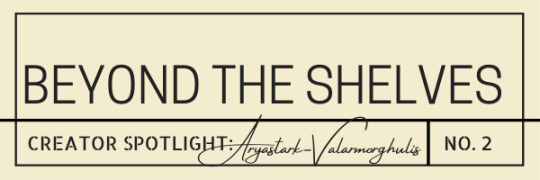
Hello lovely friends, and welcome to the second installment of the Beyond the Shelves series! This month the library is featuring @aryastark-valarmorghulis who’s beautiful prose borders on poetry, and always manages to access those lovely tender feelings we so wish to share with the world. Hope you enjoy this interview here, and make sure to check back later today for the list of her favorite fics!
Name/Creative Type: Arya (she/her) / Author
AO3: aryastark_valarmorghulis
Tumblr: @aryastark-valarmorghulis
What's your favorite thing about Remus & Sirius?
Oh, well, this answer will be incredibly sappy.
Let me begin by saying that I am truly disappointed and horrified by JK Rowling and by the harmful, awful views she’s expressed in the last years. I don’t share her ideas and I don’t support her anymore.
Having said that, HP was my childhood and is still incredibly important for me – it helped me, saved me, even, during some very dark and difficult moments, and I believe those books – as flawed as I see them now, as dated as they are – will stay with me until the very end.
Remus and Sirius have been my favorite characters since I read PoA – I was intrigued at once by that tragic yet epic backstory we only get glimpses of and I was very interested in what was left unsaid (the Marauders’ school years, the First War, how their friendship deteriorated, why Remus and Sirius reconnected so quickly).
Even a naive thirteen-year-old could see there was something worth exploring under the surface, and after a few years I opened a fanfiction on LiveJournal: it was the Shoebox Project. From that moment, I started shipping Punk and Nerd-Wolf and never stopped. Even if I left fandom quite a few times during uni, I kept coming back and I’m still here, because I think those two characters have everything a reader and a storyteller need: there’s friendship, self-discovery, queerness, love, betrayal, war and second chances. What else could I want in a pairing?
What do you think your signature is?
I’m not sure I have one, but what I really love is to let the unsaid things speak more than the actual conversations between characters. I often write from Remus’ Pov and he isn’t a big talker for me – not about his feelings anyway – so I try to convey what he doesn’t dare say, which is actually more important than what he does say.
I think objects like clothes or furniture or even houses can carry a lot of hidden significance, and very mundane actions like brewing tea or putting on a record or touching an elbow can convey more feelings than an actual conversation, so I try my best at describing all these things.
What advice would you give new authors?
Write what you like and not what you think other people will like. That's pretty obvious advice.
I would like to say something even more basic for writers like me, whose first language isn’t English: just try!
I know it can be scary to post a story written in a language that isn’t yours and there is the overwhelming fear that you’ll never be as good as a native speaker, but being bilingual can actually be a resource – you can mix together words in unexpected ways and use surprising metaphors.
I won’t lie because there are days where you don’t even know words in your mother tongue, let alone in English, but there’s no harm in trying and this is something we do for free, for ourselves first, and most of all it’s super fun to play with a new language and bend it to our will – sometimes it’s very frustrating and some sentences will never make sense but it’s nothing that a good, trusted Beta can’t fix.
My advice is that it’s worth trying.
What inspires you?/Where do you get your ideas?
I’m actually not sure; I usually get my ideas when I’m about to go to bed and I’m too sleepy and lazy to jot them down, so I can only hope I remember some vague stuff in the morning.
Most of the time I think of a particular atmosphere (a Welsh cottage in the middle of nowhere during a sweltering summer day, a chilly walk in a misty graveyard etc...) and the story develops around it.
Pick a favorite fic of yours and explain what inspired it.
Midday, Midnight is definitely my favourite fic among the ones I’ve written and, I think, the best one. I wrote it very quickly and it didn’t need much editing, except for the usual grammar stuff. It was absolutely unprecedented, it never happened again and probably never will.
I was inspired by two things.
One is this excellent piece of meta by @shaggydogstail regarding the Prank that I absolutely agree with; I was musing over a Post Prank story for a while, mostly because of my disagreement with the trope “The Prank was this huge Greek Tragedy that foreshadows the lack of trust between Remus & Sirius etc”.
The second thing I had in mind was writing something that respects Aristotle’s Classical Unities: a story that lasts for no more than 24 hours, with a single plotline and only one location. The many quotes by Ovid and Sappho underline this classic inspiration. I am acutely aware of how pretentious this sounds, just in case you were wondering.
I knew I wanted to write something about the (lack of) consequences after the Prank, and the idea of a fun summer romance came to me after reading that meta and the interesting discussion that it created.
⭐🌙
Last Month’s interview with @theprongsletthatlived can be found here.
100 notes
·
View notes
Text
Interview with Eve Golden Woods!
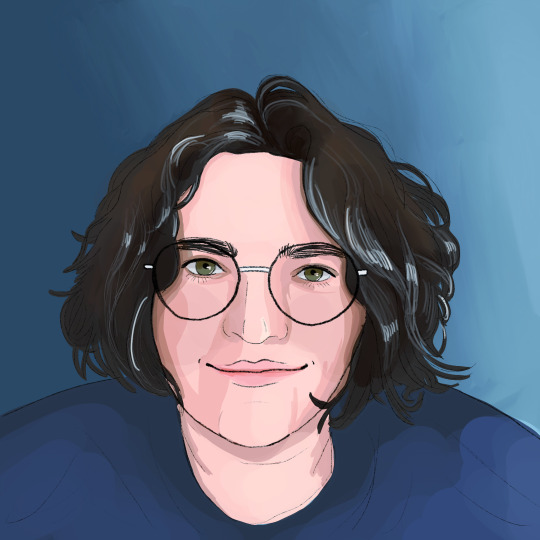
Many of you know who is Eve is. She's a writer and artist, a part of Dreamfeel studios whose beautiful game If Found won Best LGBTQ Narrative and Best LGBTQ Indie game at the first ever Gayming Awards presented by EA games. I am really excited I had the chance to ask Eve some questions about herself, her time at Lovestruck and her creative process.
Congratulations on the two Gayming Awards (Best LGBTQ Narrative, Best LGBTQ Indie Game) for "If Found" from your game studio, Dreamfeel. What was the inspiration behind making the game?
If Found... was a game that emerged out of a collaboration between Llaura McGee, the founder of Dreamfeel, and artist Liadh Young. Liadh's background is as a comic artist, and so when they started working together Llaura had the idea of showing off Liadh's art by making a diary game, and using an erasing mechanic she had previously developed to let the player move through the diary in a fun way. By the time I came on board at the start of 2019, the game had already been in development for a while, so in some ways my work on that game was similar to the work I did for Voltage, because it was taking existing characters and concepts and writing a lot of scripts for them. Unlike Voltage, though, my work for Dreamfeel was a lot more collaborative and I had a lot more creative input. I really enjoy taking something and helping to make it the best version of itself that it can possibly be, but I was also really happy that I got to reflect a lot of my own experiences in If Found. Llaura and I both grew up on the west coast of Ireland, and although If Found... isn't autobiographical for either of us, it was definitely really meaningful to be able to tell a story that reflected our own experiences of growing up as queer teens in a similar kind of environment. Since the game came out we've had fans reach out to us and tell us that they also connected to the experiences of the main characters, and as far as I'm concerned, that makes me feel like I achieved everything I wanted to.
You are a writer and a visual artist. Does one come easier to you than the other?
I used to think of art and writing as talents, and I always felt like my art was at a very mediocre level (that's probably still true, lol). So when I was younger I focused a lot more on writing. It was only later that I started genuinely trying to improve as an artist, but when I did, I think I had a much healthier mindset, and approached it as a skill I could learn with patience and effort. Because of that, even though I still have a lot more confidence in my writing, I find art more fun and relaxing, and I don't stress about it as much.
Did you always know you would follow a creative path?
Kind of? Both my parents are artists, and I grew up surrounded by artists and writers, so it was something that was always very familiar and accessible to me. On the other hand, I didn't exactly have a clear idea of how to make it into a career, or what kind of work would be involved. But there's never been a point in my life where I wasn't doing something creative, even if it was only writing fanfiction.
What did your path to working professionally as a writer/artist look like?
I did a creative writing masters in college, but after that I spent years teaching English as a second language. That was really fun and I got to live abroad, but it was so busy and tiring that I didn't have time to do any writing outside of the occasional fanfic. I only started to take art seriously again when I became interested in games and comics as ways of telling stories. I did some critical writing, which led me to speak at a few local events and get involved in zine fairs. That was how I met Llaura, the director and lead of the Dreamfeel studio, and it's also what gave me the confidence to start applying for actual writing jobs.
Is there any work of art, visual or written, that you look to for inspiration?
So many! I try to read and watch as widely as I can, although there are touchstones I always return to, like the works of Ursula Le Guin and Terry Pratchett. Right now I feel very passionate about the actual play podcast Friends at the Table, which manages to combine really thoughtful worldbuilding and storytelling with cool, fun characters and great action scenes. I'm also reading a book called The Memory Police by Youko Ogawa, which has extremely beautiful prose.
Do you have a favorite piece of your own art, whether it is something you’ve drawn, a screenshot of something you’ve written or something else?
My favourite piece of art is usually whatever I finished most recently (I think that's true for a lot of people). Especially with visual art, once a bit of time has gone by you look back on it and start to notice all your mistakes, which is very annoying. But actually I do still really like the first piece of Fiona fanart I did last year. I managed to use some effects to give it a kind of nineties anime quality that I find really fun, and I think it conveys an emotion pretty effectively. That's always one of the hardest things to predict with visual art, whether the different parts will come together to create the exact mood you're looking for.
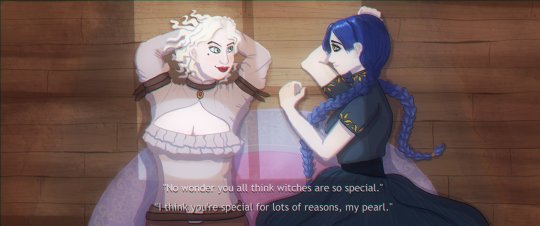
I also really like the compass I did for Bycatch. Krissy (@xekstrin) was the one who suggested filling it with fingernails, which was such a good, gross idea! As soon as I heard that I knew it was perfect and that I had to try and draw it.
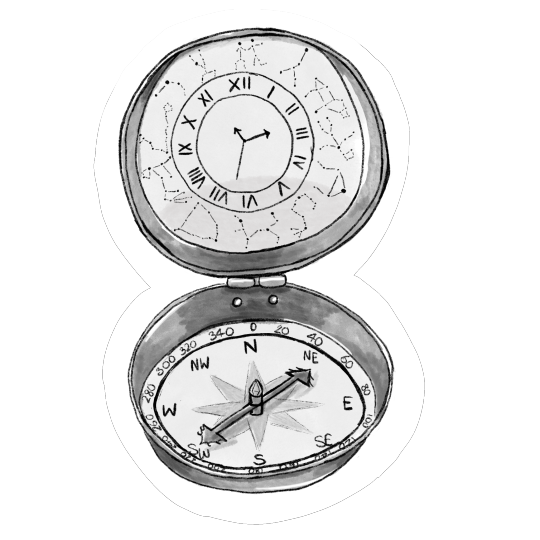
Many people who read this blog know you as a writer for Lovestruck. When you look back on your time there, what stands out in your mind?
Lovestruck was very important to me when I first started because it was my first ongoing, regular, paid writing work. It gave me a lot of confidence and helped me to get into the habit of writing consistently and rapidly, which is a really useful skill to have. I know I was right to leave when I did, though, because I am just brimming with energy to work on my own projects, and channeling that power into something that you can't control will always end up disappointing you. Also, I made a ton of incredible friends, through Lovestruck itself but then even more so through VOW (@vowtogether), and that is more than worth all the difficult parts.
Is there any character that you would have liked a crack at writing?
Oh gosh, what a fun question! There are so many, but one I do sometimes think about is Axia, just because I know there are a bunch of fans who want her route, and because I had fun writing her as a villain in Zain's route. I can see in my head the shadow of a storyline that takes place after Zain's route is over, where she's in prison and trying to understand how she lost the battle with Zain and MC. I think there's, like, a gap there, where you could see her downfall forcing her to reconsider her assumptions about power, and that could build into a very interesting redemption story. But maybe it's for the best I never got to do that, because I would have wanted full creative control over it, and also I think the story in my head is very different to the sexy, in control, menacing version of Axia that her fans enjoy.
Do you have any upcoming projects you can talk about?
Most of my current work is under NDA, but I will say that I'm doing something very exciting with other VOW members that we should be able to talk about soon(ish). Maybe I can even give a little teaser... It's not a game, but it is something you can read, and my part involves cakes, swamps, and a museum.
Do you have a favorite quote or song lyric?
It's a big long, but there's a section from The Dispossessed by Ursula le Guin that has stayed with me ever since I read it:
"For we each of us deserve everything, every luxury that was ever piled in the tombs of the dead kings, and we each of us deserve nothing, not a mouthful of bread in hunger. Have we not eaten while another starved? Will you punish us for that? Will you reward us for the virtue of starving while others ate? No man earns punishment, no man earns reward. Free your mind of the idea of deserving, the idea of earning, and you will begin to be able to think."
It's such a profoundly radical way of imagining the world, so different to everything I was raised with, but whenever I think about it I feel like I can see something very beautiful and powerful that I hope to come closer to understanding some day.
And of course, "Solidarity forever, the union makes us strong."
I was a big fan of the show Inside the Actor’s Studio. Host James Lipton asked every single guest the same 10 concluding questions. I’ve picked 3 of them:
-What is your favorite word?
My favourite word: for sound, I like words you can really roll around on your tongue. Chthonic, alabaster, insinuation. For meaning, I think simple words that encapsulate big concepts have a kind of power to them. We use them so often we forget how big they are, how much weight they really have, but they give us the space to imagine new possibilities. Love. Freedom. Revolution.
-What is your least favorite word?
I've heard that "moist" is a lot of people's least favourite word but it doesn't actually bother me. My least favourite word is probably one where I feel like the sound doesn't match the meaning. One of the Irish words for rain is báisteach, which I feel has a much weightier and more onomatopoeic sound than rain. Rain is just very flat and uninteresting.
-What profession other than your own would you like to attempt?
Oh, so many! I love history, and I think being a historian/archaeologist would be fascinating. Or something that had a physical component to it, like being a potter or a carpenter. I don't think I'd be any good, but I'd love to take the time to learn.
What would be your advice to anyone who wants to pursue a creative career?
All the work you do matters. Even the failed experiments, the things you hate when they're finished. It all helps to make you better. Also, creative career paths are often really unexpected, so chase any opportunity that seems remotely interesting. Don't work for free for anyone who can afford to pay, but work for yourself and put it somewhere. On a blog, twitter, whatever. You'd be amazed how many people get noticed and get offered opportunities because of something they made in their spare time. You'll probably have to work another job for a long time, so don't be hard on yourself if you're too tired to devote much energy to creative work. Try to make art consistently, but don't feel like that has to mean every day. Don't chase after celebrities. Make friends with your peers.
50 notes
·
View notes
Text
Great comprehensive interview with Elvira on the making of The Letter Room and filmmaking, in general. One interesting tidbit mentioned: she is currently developing a podcast about sex. 👀🤔

For most of her creative life, Elvira Lind has been behind the the lens compassionately capturing true stories as a documentary filmmaker. Her debut feature, Songs for Alexis, observes two young lovebirds navigating a long distance relationship and challenging views on gender identity in the modern age. While her sophomore feature, Bobbi Jenne, explores the life of a famous dancer fighting for her own creative and personal independence.
Despite her prolific doc work, a story that couldn't simply be told in its raw form kept circulating in her head: a dark prison comedy about the secret life of a correctional officer trying to bring humanity to the prison system. When he gets transferred to a job in the letter room, he finds himself a little too involved in the private lives of the inmates.
Far along in her second pregnancy, and with the support of an incredible team of collaborators, Elvira took on the challenge of writing and directing her first narrative short, "The Letter Room." The film stars Oscar Isaac and Alia Shawkat, and has had an all-star festival run, screening at Telluride, Tribeca, and the Palm Springs International Film Festival. Here, Elvira reflects on the joys and challenges of creating your first short film—putting empathy first, reshaping the tropes around pregnancy, and screening in the COVID era.
vimeo
FTW: How did you become a filmmaker?
Elvira Lind: I’ve always loved film. I was very drawn to documentaries because it felt like you were entering something that was really happening. You opened a door and were already inside the film. You’re just trying to keep up with what’s being thrown at you. As opposed to fiction where you have to conjure it up from nowhere. I loved imagining and writing stories when I was little, but I didn’t have the confidence to pursue it.
I didn’t come from a family of filmmakers. And I came from a time when people had a little shitty camcorder that you borrowed from someone’s uncle, and buying film was expensive. Things opened up and changed a lot when cameras became more accessible.
I could only afford one year of film school in Cape Town, where I met some amazing people and learned about so many different ways of storytelling. I came back to Denmark and found myself working for free a lot for other filmmakers while doing a side job. The paid work was very hard to get, but I’d rather work for free with filmmakers that I loved and have more responsibilities than have access to nothing. It wasn’t easy to find my way in, but it’s so worth it.
And now you live in New York. How does this global background affect your general filmmaking style and approach?
I definitely bring a lot of Danish documentary traditions with me and hold it very dear. There are a lot of kick ass female documentary filmmakers in Denmark that have taught me a lot. There’s a good support system for women there. It’s an incredibly privileged place in that there’s funding from the government to make films. You can make things that, in my opinion, are often far more interesting because it’s not reliant on how it’s going to make money in the box office.
You’ve shot many of your documentaries in the past. So what was it like this time to be working with a cinematographer?
I always wanted to work with a cinematographer on my documentaries; we just couldn’t afford it. Now for “The Letter Room”, I worked with Sam Chase, who has got such a brilliant eye and it was wonderful to have someone to work with on composing the look of the film because I’m usually doing it by myself. It is kind of like a marriage. I work with the same editor on all my projects as well. You enter this symbiotic sort of dance together. For me, it also means you have to fight about things and disagree and then make up and hear each other out. My editor, Adam Nielsen, is the kind of guy who just comes up with genius ideas while in the shower or on the way home from work on his bicycle. You have to find these key people in your life where you can bounce ideas back and forth with.
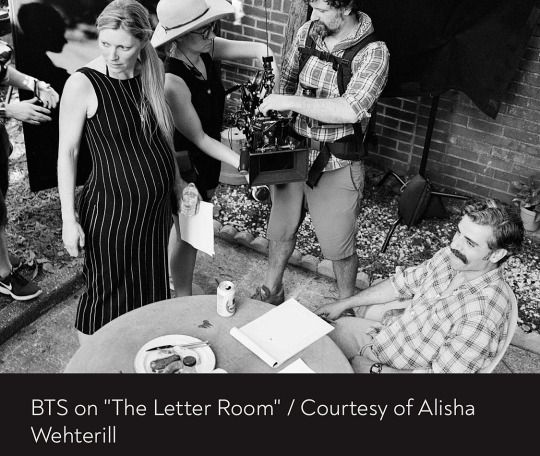
Where did the idea for “The Letter Room” come from?
It was a story that was brewing in my head for a long time, but I wasn’t sure how to put a narrative film together. I just started to write it down and then it kept developing.
There was a podcast that I listened to that really inspired me. It told the story of different men who were all unknowingly writing love letters to the same woman. She started to ask for money and help with rent, but the letters she wrote were so wonderful and all these men were very in love with her. These very lonely men felt like magic had entered their lives. They all eventually found out that the woman was actually a man writing to different people trying to get their money. They were all heartbroken, but one of the men said that the worst part was losing these letters and that the fantasy was gone. He wished they could just keep writing to each other. So much of life is fantasy and trying to live through other people’s lives. I’m very drawn to stories of loneliness and bottled up feelings.
And then I am firmly against the American prison system. It’s heartbreaking, frustrating, and I can’t make sense of it. How do you even begin to explain this system to a child?
It’s a society that doesn’t care about humanity. I wanted to show the monotony, the repetition, the sadness. I don’t see the bigger goal or purpose of locking people away for countless years and taking away all the things that makes you feel human, that makes life joyous. I really believe that we can all change and this system teaches people nothing. “The Letter Room'' is the combination of these two concepts that I’m very passionate about.
And then I got pregnant for the second time and I hadn’t made a film between the two. It was a crazy feeling to be taken over again by pregnancy. A wonderful friend of mine, Sofia Sondervan-Bild, came to me and said, “I think you should make this film and I’ll make it with you.” Initially, I freaked out and thought I didn’t know how to do fiction and doubted how I could make a film in a prison, but she inspired me and told me to do it. She’s just one of these incredibly powerful people that you want to go on an adventure with. She made me feel like my pregnancy wasn’t going to stand in the way of me making this film. We ended up shooting while I was far along in my pregnancy in a prison in the middle of a summer heat wave. It was crazy, but it was the best thing that I could’ve done at the time.
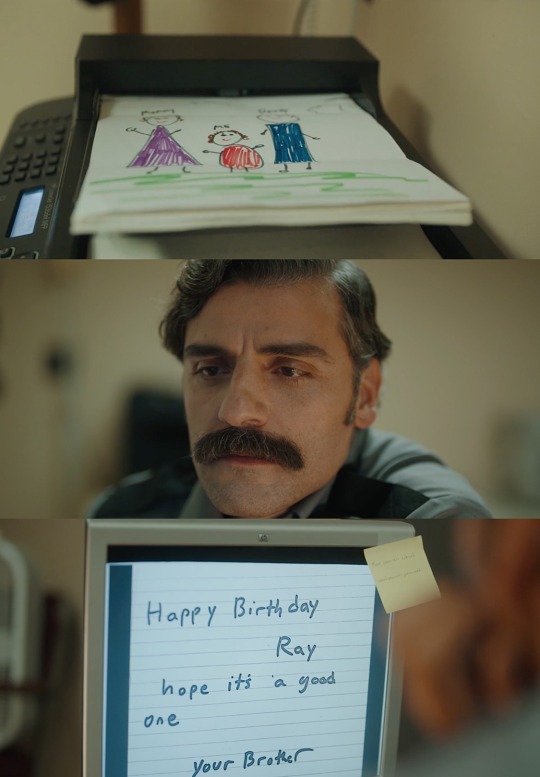
When you were directing on set at that stage of pregnancy, did you feel like you were reshaping tropes of what women are capable of?
It was insane. The funny thing was that the crew was like, “we can’t complain that we are tired because she is extremely pregnant and still running around.” I was so high off of that experience. When we finished, I collapsed. I fell straight onto the couch and then I have a two and a half year old screaming my name. That was more work for me than directing the short. I edited the film right before I gave birth actually, and then I gave birth and did sound right after. I was pumping breast milk in the corner in the darkness during the sound edit.
I’ve learned a lot from surpassing whatever I thought was physically possible with being pregnant. I learned that being in a creative process gives you so much energy that it allows you to be in whatever shape, size, form, mental space you can. People are ready to give you their support, if you choose the right people. I’m really grateful that I chose such wonderful collaborators who supported me through it all. Even when people were questioning my choice to direct a film while being pregnant in a prison. Why not? Women get pregnant and then we still need to be supported so that we can continue to make the things we want to do.
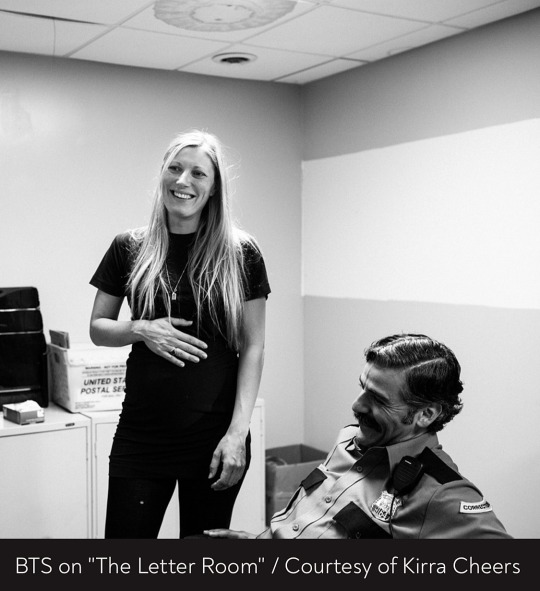
What was your experience with getting “The Letter Room” funded?
It’s really hard, let’s be honest. There aren’t a lot of people sitting around waiting to fund a short film. We ended up working with Topic, which is a part of First Look Media. They are just incredible and really support filmmakers with whatever their vision is. I’ve had great experiences and some really bad experiences with funding, so I know this was an ideal scenario.

Having a short that is over 30 minutes long seems like a feat. At what stage in the process did you know this was going to be a longer piece? And how did that decision affect the shoot in both positive and difficult ways?
It was way too long at first, and when I shortened it, it was still 32 minutes. We could only afford five days of shooting, and a lot of it is shot on active prison grounds, which have an insane amount of protocol. We almost used everything we shot.
I’m not used to being able to have different angles to choose from in my doc work, so I think I just knew exactly what I wanted. I know that my producers were worried that I wasn’t getting enough, but to me, I was like, I’m getting double of what I usually get on a documentary! Everyone was quietly concerned, but everything worked out when we got to the edit.
The short’s length hasn’t done any favors for me so far, but you need to breathe as an audience, you need to pace it out. If I cut out certain minutes, it would’ve felt rushed and you wouldn’t have believed the arcs that the characters had.

I loved the concept of placing a very empathetic character in a setting that is contrary to that personality type. You included so many details that made the world feel so three dimensional and cared for. Can you talk about those decisions to create that feeling?
It means so much to me that it made you feel that way. What frustrates me about the prison system is that it lacks any empathy or understanding of human nature and nurture and who we are. What we need to become better people. It takes all of that away.
I spoke to people who have spent a lot of time in prison and they told me that you have to hide your feelings and that showing any signs of weakness will be a disaster. It’s the worst possible scenario you can imagine yourself in. Being robbed of every privacy, anything that makes you happy, anything that makes you feel like yourself. I imagined the character of a caregiver in this setting who wants to help and finds a silly way to do so. I was very inspired by that story of the love letters that I talked about earlier. What does it mean to lie if you’re making someone else happy?
It’s the morning of your first day of the shoot — how do you feel?
I was very nervous. I had never said ‘action’ before. I’ve been on a lot of sets, but I didn’t want to seem like I didn’t know what I was doing, but it’s also okay not to know. Mistakes are going to happen, and sometimes they become gifts. At the same time, I was very excited. You come in and there are all these people there with you who are there to make this thing you’ve written come to life.
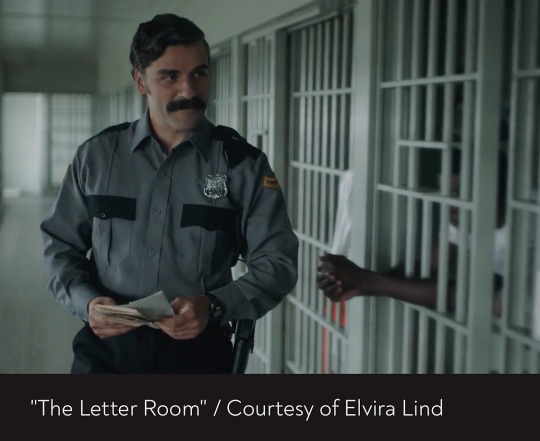
What are some things you would do on set to create a safe space and vulnerable environment?
We did everything we could to make the set a safe space. It was very difficult and stressful to shoot in an active prison, but we made sure to actively ask our crew if everyone’s feeling okay and if we can do anything to make the situation better. I’m very vulnerable and encourage all of my crew to be vulnerable with me. Mistakes are welcome.
It's a short film, people come and work on this not because they’re making a million dollars, but because they want to be there and are being incredibly generous with their time and energy. It was such a good environment that even when challenging things came up, it was still a lot of fun.

What was it like working with actors for the first time?
That was one of the biggest challenges for me. I’ve heard so many different stories in passing of the least helpful note or worst thing to say to an actor. You want to be respectful and actors have their way of working. Ultimately, they are all really talented actors and all of them came with so much energy and a lot of ideas.
I spent time with each of them talking about their character. Those 1 on 1 conversations helped me a lot in the writing process as well because you’re bouncing ideas off of each other and they’re asking you questions about how they would respond to a certain situation.
I had always imagined Alia Shawkat as Rosita and she ended up wanting to do it and came from LA to film it. I had tears in my eyes when we were filming the scene of her and Oscar. They were excited to do the scene together. It was all a dream.
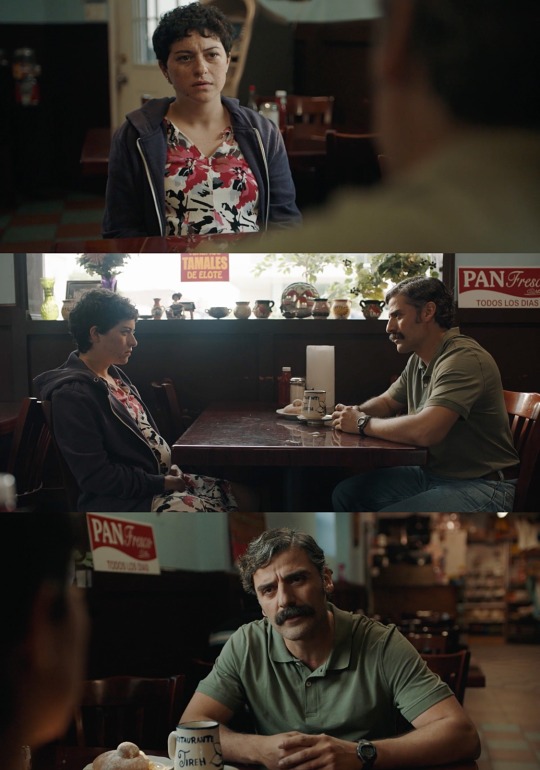
What was the experience of working creatively alongside your partner like?
We were joking a lot about it before because there was already the stress of being so pregnant and we have a 2 year old at home, and now I was putting us in another highly intense and demanding situation. Either it was going to be great OR we would drive each other nuts. But we had so much fun. It was wonderful to work together. I was so happy to be on set and make my film and he’s just so talented and fun to be around. Those little moments where you know each other so well—I’d give him notes and he just kept surprising me and was so respectful of my directions.
He found this photo for him to connect to the character and it became very fundamental to me. It was this incredible black and white photo from the 70s of a prison guard. I had always imagined that he would have this inner salsa soundtrack playing in his soul and we would play Rubén Blades and 70s salsa music and Oscar just morphed that into music into everything and created this unique character.
And he was wearing a fat suit the entire shoot and I was pregnant and Alia Shawkat had her pregnant belly on. The three of us—it was so funny.
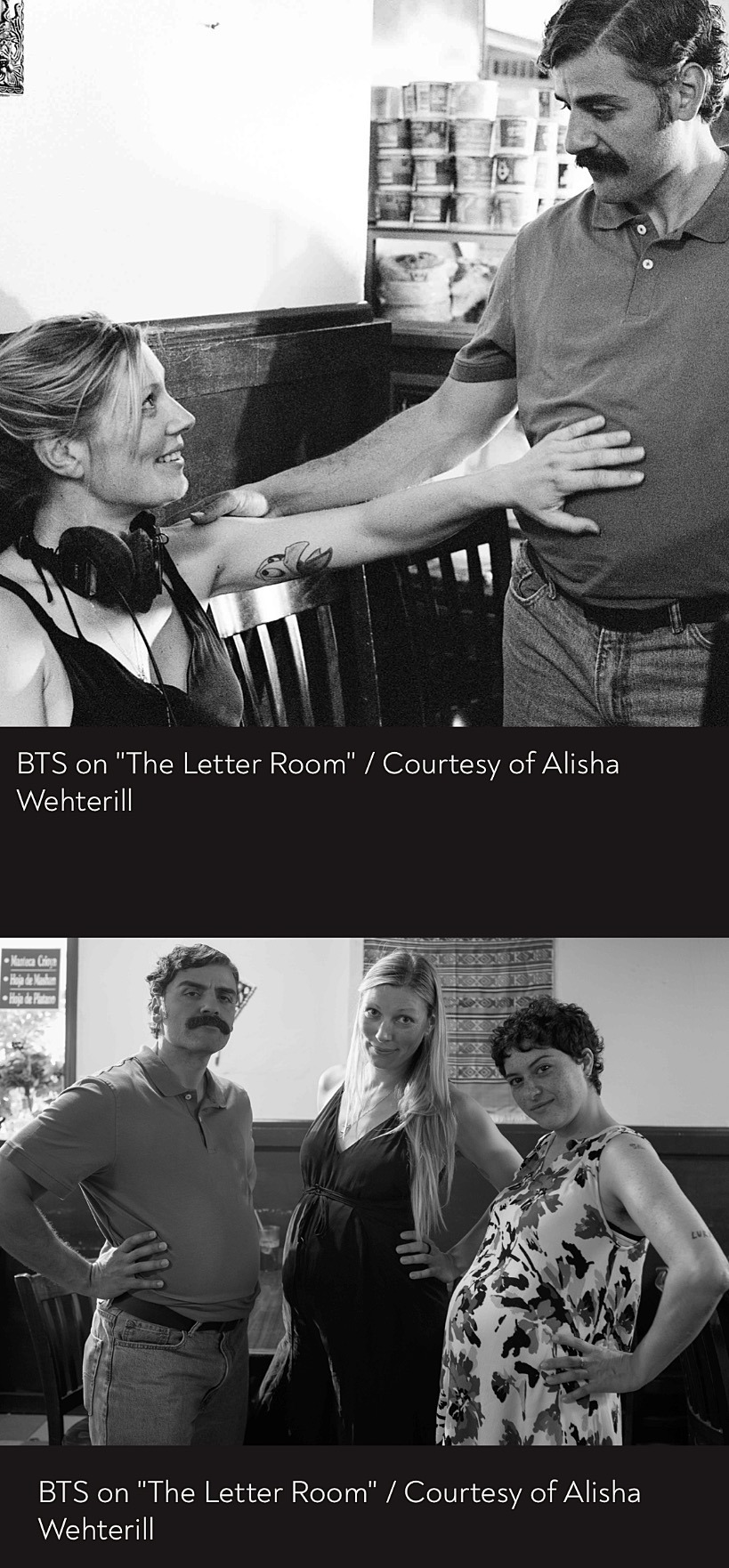
It seems like the perfect first experience of going into narrative with people that you really trust and support you.
Definitely! Find the people that you can team up with that really believe in your vision and who will push you to do exactly what you had in mind. People who never try to push you into these conventional routes. Our creative voices are so fragile. You want to be on the same page so that they see what you’re trying to do and want to bring that out of you. Where they’re treating your film as a sacred thing that you’re creating together.
How do you know when a film is done?
Fiction is very different from documentaries. With documentaries, it never feels like it’s done because there are so many options. That’s also why I love fiction so much; It’s so much faster. It’s a whole different beast to tame a documentary with hundreds of hours of footage where you’re reinventing the wheel every day.
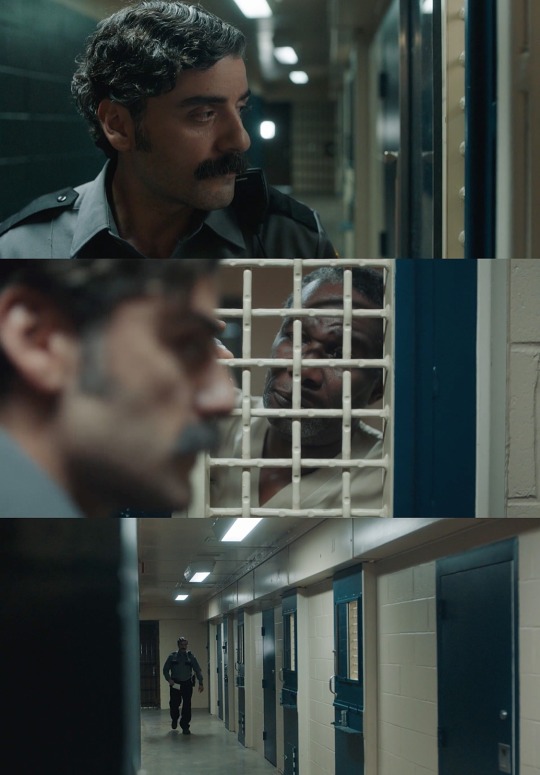
How have you built up your own confidence as a director and your unique voice?
Stubbornness. I’ve had many experiences working with people who didn’t believe in my project. You have to stick to your guns and trust your instincts. Once you find your voice, you find people that want to go on that ride with you and find your vision interesting. It’s a miracle when any of us gets a project made, so your confidence can’t come from how much money your movie made. It has to come from somewhere else. Did you do justice to the people you portrayed in your story? Did anyone walk away feeling like something had changed within them?
What is a good director to you?
Someone who is driven with passion without letting that passion take over and become any source of frustration that’s taken out on other people. It should feel like a collaborative effort. And having gratitude every day that you’re making something with other people who are donating their time. You’d be nowhere without them. One of the most important things is making sure that your crew is treating everyone equally. It depends on the size of the production, but having someone who can sense what’s happening in all different departments and having department heads that are there to protect everyone. Listen to each other, and make sure everyone feels safe and is in the best place to be creative.
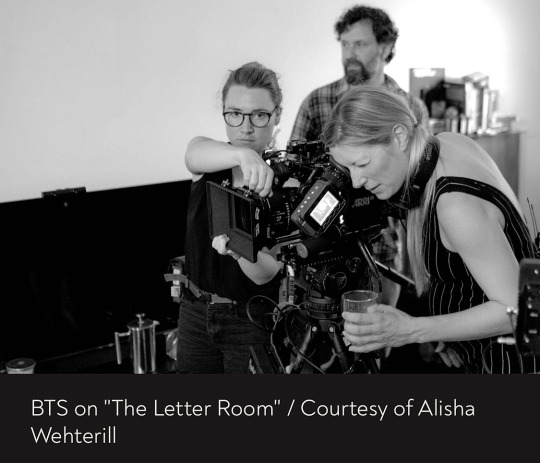
With COVID, what has the adjustment been like to being in an online space for this festival run?
I’m really deeply saddened by not having the human interaction aspect of it. It feels so crucial to be in the room together, to meet and see each other's projects and share the experience, to cry and laugh next to people you don’t know. I’m grieving to be honest. We just gotta get through this time. It reminds us of how sacred it is for us to gather and how that feels, and I hope that all of that will come back after this and that cinemas will survive. We really need them.
What’s next for you?
Right now I’m writing more fiction and working on a new documentary feature that I am kind of researching and shooting at the same time. I am also creating a podcast about sex, called “The List” with my friend, writer and photographer Kirra Cheers, based on a book and play she wrote. My husband and I just started a production company together, Mad Gene Media, in order to develop and produce our own material. So. lots of exciting things to continue with in the new year.

Born in 1981 in Copenhagen, Elvira Lind graduated from School of Media and Creative Arts in Cape Town in 2006 majoring in documentary film where she received two awards for her final year achievements. She has worked within that field since directing and shooting documentaries of various lengths for TV, cinema and web on 4 different continents.In 2020 she premiered her first fiction project, a 32 min short film she wrote and directed. The film was sold to Topic and was invited to various festivals including Telluride and Tribeca FF. Elvira's feature doc BOBBI JENE premiered at Tribeca Film Festival in 2017 where it won all awards in its category including Best Feature documentary, best editing and best Cinematography. The film had theatrical release in US, Spain and Scandinavia.Elvira's first documentary feature Songs for Alexis premiered at Toronto HOT DOCS in 2014 and screened and competed at a long list of international festivals. Her 8 part documentary TV series "Twiz and Tuck" was bought by VICELAND and launched in 2017. Elvira now lives and works out of New York.
###
91 notes
·
View notes
Text
To land ‘Loki,’ Kate Herron had to pull out all the stops. How she won over Marvel
As a teenager, Kate Herron was obsessed with the “Lord of the Rings” films.
In particular, she recalls heading to theaters repeatedly with friends who shared her passion to see “The Two Towers” (2002), the second installment in director Peter Jackson’s trilogy based on J.R.R. Tolkien’s epic fantasy novel. She even wrote “Lord of the Rings” fan fiction.
“It was very silly,” the British filmmaker insists, revealing that one of her stories saw the heroic Fellowship traveling through a magical fountain and getting trapped in New York. “Honestly, I was just writing the stories to make my friends laugh. I guess it was kind of that first foray for me: ‘How do I tell a story?’”
Years later, Herron is again involved in telling a story about a protagonist displaced from the world he knows. But this time, her audience is much bigger.
Herron, 33, is the director of “Loki,” the Marvel Studios series that follows the adventures of the titular god of mischief after he has been plucked out of time by an agency charged with maintaining the sanctity of the timeline. Thus, the six-episode series, which premiered earlier this month on Disney+, features a slightly different version of Loki than the fans of the Marvel Cinematic Universe have grown to love since his first appearance in “Thor” (2011) through “Avengers: Endgame” (2019).

“I love villains,” says Herron during a recent video call from Atlanta, where she is putting the final touches on “Loki.” “I think that if a villain’s done right, you don’t necessarily have to like their actions, but you have to understand them. And I think that Tom [Hiddleston], in the last decade, has brought such empathy and wit and pain to a very real character for so many people. I just wanted to be part of whatever [Loki’s] next chapter was going to be.”
The series, on which the self-described Loki fan also serves as an executive producer, is Herron’s highest-profile project to date. Her previous credits include directing on Netflix’s “Sex Education,” as well as “Five by Five,” a series of short films executive produced by Idris Elba.
While growing up in South East London, Herron never considered filmmaking as a career. Her love of movies manifested as the aspiration to become an actor, and she often goaded her peers into putting on plays or making movies using a friend’s father’s camcorder. It wasn’t until some astute and encouraging teachers at Herron’s secondary school pointed out that she seemed more interested in storytelling that she changed course.
By introducing Herron to new texts, these teachers — as well as a film studies class that covered films directed by Stanley Kubrick and Akira Kurosawa — helped expand her perspective.
“I just didn’t know that you could have a voice and an authorship over a film, which probably sounds a bit silly. But I just hadn’t really thought about films in that way,” says Herron. Soon enough, she was on the path to film school at the University for the Creative Arts in Farnham, England, where she graduated with a degree in film production.
Herron laughs as she remembers how she believed she would just go off and find work in film straight out of school. “Obviously that did not happen,” she says.
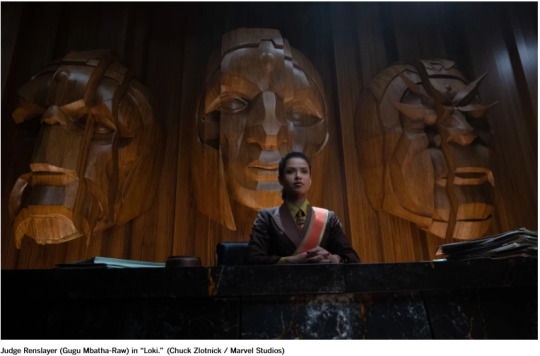
With no post-graduate roadmap (or job offer) to help her break into the industry, Herron eventually started writing and directing short films with “no money” while juggling a day job as a temp. Both experiences provided Herron with material for “Loki,” which introduces a new bureaucratic agency called the Time Variance Authority to the MCU.
“I’ve worked at a lot of random places, which weirdly has influenced ‘Loki’ in some ways because we have this office culture kind of running through it,” says Herron. “I’ve worked in a lot of offices.”
In order to give the retro-futuristic offices of the TVA “a real lived-[in], breathed-in office” feel, Herron incorporated details that viewers could recognize from the real world — from paper files to the posters on the walls — and gave them a fantastical twist befitting the superhero series.
“One of the most exciting things to me about Kate is she has this amazing attention to detail,” says “Loki” co-executive producer Kevin Wright. “That was something that we saw on her very first pitch [and] it works its way into every frame of the show. Every monitor, every piece of paper in the TVA … she has looked over and approved everything you see.”
In an email, “Loki” star Hiddleston described Herron as “a dream collaborator” who possesses “a unique combination of extraordinary diligence, stamina, energy, respect and kindness.”
“Her affection for and understanding of Loki was so deep, profound and wide-ranging,” Hiddleston wrote. “She built a new world for these characters to play in with incredible precision, but she was also acutely sensitive to their emotional journey.”

Herron’s affinity for outsiders is apparent throughout the course of our conversation. There is of course her love for Loki — the heir to the king of Frost Giants raised as the prince of Asgard who has become one of the MCU’s most beloved villain-turned-antiheroes. Herron’s first introduction to the world of Marvel as a kid was through “X-Men: The Animated Series,” about the superhero team with mutant powers that set them apart from average humans. Herron cites Lisa Simpson — the overachieving, opinionated middle child from the animated sitcom “The Simpsons” — as the reason she is a vegetarian who can play the saxophone.
And although Herron describes herself as shy, it’s no match for the passion she brings to discussing film and television.
She calls Wes Anderson’s 2001 film “The Royal Tenenbaums,” co-written by “Loki” actor Owen Wilson, “a perfect movie.” In addition to being obsessed with “The Simpsons,” Herron gravitated toward genre shows such as “Buffy the Vampire Slayer,” the updated “Battlestar Galactica” and “The X-Files” when growing up.
As Herron enthusiastically dives into “Loki’s” influences — which include “Alien” (1979), “Blade Runner” (1982), “Brazil” (1985), “Metropolis” (1927) and, yes, even “Teletubbies” — it’s easy to see why Wright knew she was the right person to bring “Loki” to life from their very first meeting.
Upon learning that Marvel was developing a show about Loki, Herron tasked her agents with calling Marvel every day until they would meet with her. And it worked.
“I was just so excited that somebody was chasing the project,” says Wright. “Which sounds crazy, that Marvel would be excited somebody’s chasing us. But it was the early days of us trying to get this Disney+ streaming stuff off the ground, so people were very hesitant … they didn’t know what it was yet.”
Herron’s enthusiasm for the show landed her a video meeting with Wright and executive producer Stephen Broussard. Believing it might be her only shot at the project, Herron came armed with so many stills and clips to illustrate her discussion of the scripts she’d been sent that a simple meet-and-greet turned into a four-hour conversation.

“Over the course of the next week or so,” Wright explains, “it was really figuring out how to set Kate up to succeed when we got her in front of Kevin Feige to pitch this.”
Herron put together a 60-page bible of ideas for the characters, the story, the visual references and more. The rest is Marvel history.
She learned not to wait for permission, she says, after graduating from film school and becoming involved with improv and stand-up to both develop her comedy chops and to meet funny collaborators to be in her short films.
“I think I’d always find excuses, almost, [to not do it],” says Herron. “It was that thing of being like, ‘Oh, well, I’m not ready. So I’ll wait. I’ll wait until I’m perfect at it and then I’ll go do it.’”
Taking inspiration from Robert Rodriguez’s “Rebel Without a Crew” and a SXSW keynote speech by Mark Duplass, Herron realized that she just needed to start making things. She told herself it was OK if the films were messy. If a short was bad, nobody had to see it. If a short was “halfway to good,” she would submit them to festivals.
It’s this tenacious creativity that connects the dots between her early fan fiction, her short films, her pitch presentations — and now “Loki” itself. It’s a trait that has helped her navigate the industry to her current success, even during the periods it’s been most frustrating. As a female director, “I got asked crazy stuff in interviews sometimes,” she says of life on the festival circuit. “I remember being asked, ‘Are you sure you’re ready? Are you sure you’re ready?’ And male colleagues of mine were never asked that in interviews. I think that’s probably why I was so driven to just go out and make stuff.”
21 notes
·
View notes
Text
The Supernatural 70s: Part I - Corruption of An Innocent
"We're mutants. There's something wrong with us, something very, very wrong with us. Something seriously wrong with us - we're soldiers writers."
-- with apologies to the screenwriter of "Stripes"
Dear reader, I have the darkest of revelations to make to you, a truth when fully and wholly disclosed shall most assuredly chill you to the bone, a tale that shall make you question all that you hold to be true and good and holy about my personal history. While you may have come in search of that narrative designer best known for his works of interactive high fantasy, you should know that he is also a crafter of a darker art, a scribbler of twisted tales filled with ghosts, and ghouls, and gargoyles. I am, dear innocent, a devotee of horrors! Mwahahahaha!
[cue thunderclap, lightning, pipe organ music]
Given the genre of writing for which most of you know me, I forgive you if you think of me principally as a fantasy writer. I don't object to that classification because I do enjoy mucking about with magic and dark woods and mysterious ancient civilizations. But if you are to truly know who I am as a writer, you must realize that the image I hold of myself is principally as a creator of weird tales.
To understand how and why I came to be drawn to this sub-genre of fantastic fiction, you first must understand that I come from peculiar folks. Maybe I don't have the Ipswich look, or I didn't grow up in a castle, but my pedigree for oddity has been there from the start. My mother was declared dead at birth by her doctor, and often heard voices calling to her in the dead of night that no one else could hear. Her mother would periodically ring us up to discuss events in our lives about which she couldn't possibly have known. My father's people still share ghost stories about a family homestead that burned down mysteriously in the 1960s. Even my older brother has outré memories about events he says cannot possibly be true, and as a kid was kicked off the Tulsa city bookmobile for attempting to check out books about UFOs, bigfoot, and ESP. It's fair to say I was doomed - or destined - for weirdness from the start.
If the above listed circumstances had not been enough, I grew up in an area where neighbors whispered stories about a horrifically deformed Bulldog Man who stalked kids who "parked" on the Old North Road near my house. The state in which I was raised was rife with legends of bigfoots, deer women, and devil men. Even in my childhood household there existed a pantheon of mythological entities invented explicitly to keep me in line. If I was a good boy, The Repairman would leave me little gifts of Hot Wheels cars or candy. If I was being terrible, however, my father would dress in a skeleton costume, rise from the basement and threaten to drag me down into everlasting hellfire (evidently there was a secret portal in our basement.) There were monsters, monsters EVERYWHERE I looked in my childhood world. Given that I was told as a fledgling writer to write what I knew, how could anyone have been surprised that the first stories I wrote were filled with the supernatural?
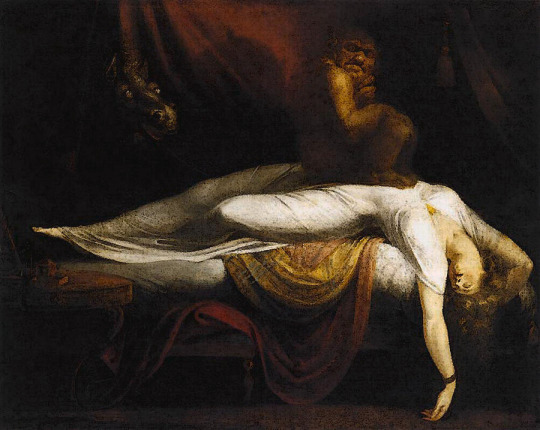
"The Nightmare" by John Henry Fuseli (1781)
My formative years during the late sixties and early seventies took place at a strange juncture in our American cultural history. At the same time that we were loudly proclaiming the supremacy of scientific thought because we'd landed men on the moon, we were also in the midst of a counter cultural explosion of interest in astrology, witchcraft, ghosts, extra sensory perception, and flying saucers. Occult-related books were flying off the shelves as sales surged by more than 100% between 1966 and 1969. Cultural historians would come to refer to this is as the "occult boom," and its aftershocks would impact popular cultural for decades to come.
My first contact with tales of the supernatural were innocuous, largely sanitized for consumption by children. I vividly remember watching Casper the Friendly Ghost and the Disney version of the Legend of Sleepy Hollow. I read to shreds numerous copies of both Where the Wild Things Are and Gus the Ghost. Likely the most important exposure for me was to the original Scooby Doo, Where Are You? cartoon which attempted to inoculate us from our fears of ghosts and aliens by convincing us that ultimately the monster was always just a bad man in a mask. (It's fascinating to me that modern incarnations of Scooby Doo seem to have completely lost this point and instead make all the monsters real.)
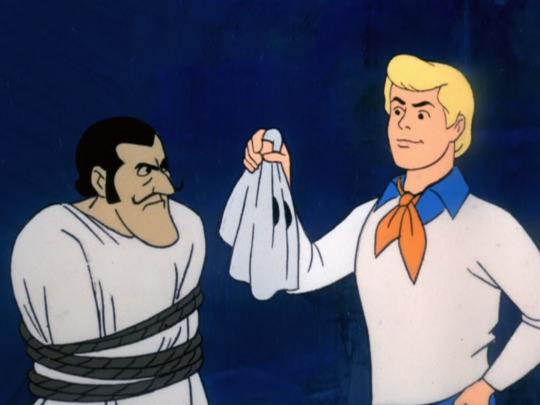
ABOVE: Although the original cartoon Scooby Doo, Where Are You? ran only for one season from 1969 to 1970, it remained in heavy reruns and syndication for decades. It is notable for having been a program that perfectly embodied the conflict between reason and superstition in popular culture, and was originally intended to provide children with critical thinking skills so they would reject the idea of monsters, ghosts, and the like. Ironically, modern takes on Scooby Doo have almost entirely subverted this idea and usually present the culprits of their mysteries as real monsters.
During that same time, television also introduced me to my first onscreen crush in the form of the beautiful and charming Samantha Stevens, a witch who struggles to not to use her powers while married to a frequently intolerant mortal advertising executive in Bewitched. The Munsters and The Addams Family gave me my first taste for "goth" living even before it would become all the rage in the dance clubs of the 1980s. Late night movies on TV would bring all the important horror classics of the past in my living room as Dracula, Frankenstein, the Wolf Man, the Invisible Man, the Phantom of the Opera, The Creature from the Black Lagoon, and Godzilla all became childhood friends. Over time the darkened castles, creaking doors, foggy graveyards, howling wolves, and ever present witches and vampires became so engrained in my psyche that today they remain the "comfort viewing" to which I retreat when I'm sick or in need of other distractions from modern life.
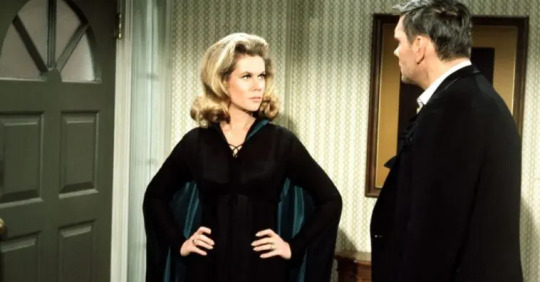
ABOVE: Elizabeth Montgomery starred in Bewitched (1964 - 1972) as Samantha Stephens, a witch who married "mortal" advertising executive Darren Stephens (played for the first five seasons by actor Dick York). Inspired by movies like I Married a Witch (1942) and Bell, Book and Candle (1958), it was a long running series that explored the complex relationship dynamics between those who possess magic and those who don't. Social commentators have referred to it as an allegory both for mixed marriages and also about the challenges faced by minorities, homosexuals, cultural deviants, or generally creative folks in a non heterogeneous community. It was also one of the first American television programs to portray witches not as worshippers of Satan, but simply as a group of people ostracized for their culture and their supernatural skills.
Even before I began elementary school, there was one piece of must-see gothic horror programming that I went out of my way to catch every day. Dark Shadows aired at 3:30 p.m. on our local ABC affiliate in Tulsa, Oklahoma which usually allowed me to catch most of it if I ran home from school (or even more if my mom or brother picked me up.) In theory it was a soap opera, but the show featured a regular parade of supernatural characters and themes. The lead was a 175 year old vampire named Barnabas Collins (played by Johnathan Frid), and the show revolved around his timeless pursuit of his lost love, Josette. It was also a program that regularly dealt with reincarnation, precognition, werewolves, time travel, witchcraft, and other occult themes. Though it regularly provoked criticism from religious groups about its content, it ran from June of 1966 until it's final cancellation in April of 1971. (I would discover it in the early 1970s as it ran in syndication.) Dark Shadows would spin off two feature-length movies based on the original, a series of tie-in novels, an excellent reboot series in 1991 (starring Ben Cross as Barnabas), and a positively embarrassingly awful movie directed by Tim Burton in 1991.
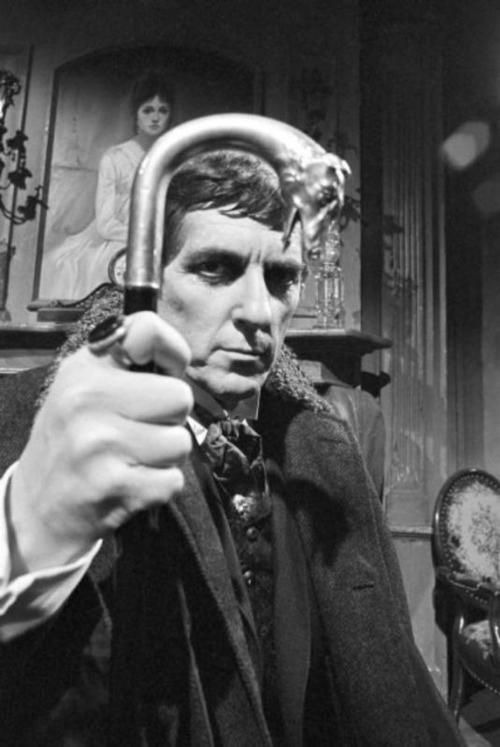
ABOVE: Johnathan Frid starred as Barnabas Collins, one of the leading characters of the original Dark Shadows television series. The influence of the series cannot be understated. In many ways Dark Shadows paved the way for the inclusion of supernatural elements in other soap operas of the 1970s and the 1980s, and was largely responsible for the explosion of romance novels featuring supernatural themes over the same time period.
While Dark Shadows was a favorite early television program for me, another show would prove not only to be a borderline obsession, but also a major influence on my career as a storyteller. Night Gallery (1969-1973) was a weekly anthology television show from Rod Serling, better known as the creator and host of the original Twilight Zone. Like Twilight Zone before it, Night Gallery was a deep and complex commentary on the human condition, but unlike its predecessor the outcomes for the characters almost always skewed towards the horrific and the truly outré. In "The Painted Mirror," an antiques dealer uses a magic painting to trap an enemy in the prehistoric past. Jack Cassidy plots to use astral projection to kill his romantic rival in "The Last Laurel" but accidentally ends up killing himself. In "Eyes" a young Stephen Spielberg directs Joan Crawford in a story about an entitled rich woman who plots to take the sight of a poor man. Week after week it delivered some of the best-written horror television of the early 1970s.
In retrospect I find it surprising that I was allowed to watch Night Gallery at all. I was very young while it was airing, and some of the content was dark and often quite shocking for its time. Nevertheless, I was so attached to the show that I'd throw a literal temper tantrum if I missed a single, solitary episode. If our family needed to go somewhere on an evening that Night Gallery was scheduled, either my parents would either have to wait until after it had aired before we left, or they'd make arrangements in advance with whomever we were visiting to make sure it was okay that I could watch Night Gallery there. I was, in a word, a fanatic.
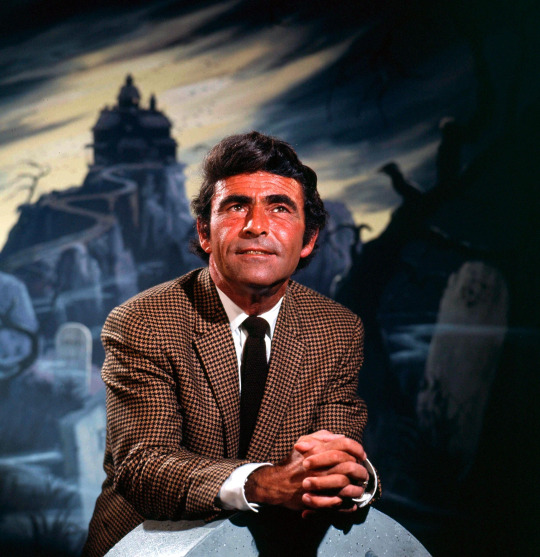
ABOVE: Every segment of Night Gallery was introduced by series creator Rod Serling standing before a painting created explicitly for the series. Director Guillermo del Toro credits Serling's series as being the most important and influential show on his own work, even more so than the more famous Twilight Zone.
7 notes
·
View notes
Text
documentary
big fat catchup
I haven't written much (actually nothing at all) about this module so far, apologies ://
So, I joined Jack's 'Khanistan' doc. I have to quickly say that it will no longer be called this. Some people know why, if you don't, good for you! (inside jokes 4 the girls). I think we may go with 'The Block', this is what the community call it. Anyways, I liked the idea and was very interested in meeting the people Jack had mentioned. I have always been amazed/impressed by people who "live by their own rules" and "off the grid", in a sense, I'm aware it's not exactly this but was unsure how to word it.
We have our roles:
Director - Jack
Producer - Rowen
Cinematographer - Jenny
Edit - Myself
Sound - Orla
We all got the bus to Glasgow last week to visit Florence, Jack's brothers girlfriend - who was just the loveliest person!! Jenny took many photos, I will show a few throughout the blog!



I won't get too into the visit as I want to focus on aims/visions for the documentary. But I made a Proof of Concept ish, that i'll link: The Block - POC . However, I want to note that I cannot use my camera very well and I have no clue how sound works. Enjoy!
I have been thinking about themes and angles we can push with this project, as there are a few ways we can take it. There's the bond between a community that I like, which I think still follows the brief as we wouldn't be focusing on a specific person, but a community of people making a place a home, without them it wouldn't be as special. Linking to this they all put their own creative spin on rooms and exterior, which is a focus I like. Florence had mentioned the summer at the building, in which they all sat for hours in the garden. With a bonfire, music, drinks, drugs and art. She explained how close they all were during this time, and showed us photos / polaroids / videos. However, now it is not so warm they don't spend much time together anymore, and the garden is not so beautiful and colourful as it once was. Which is another possible focus, changing of season and friendships. Also, there is the whole thing with Mr Khan himself, the man who rents the rooms and owns the buildings. From the stories we heard, everything he does is insane, it's actually not legal I don't think. From not fixing broken windows to 'allowing' squatters. I would love to focus on him and how he came into possession of the building and his morals and his life and everything about this mysterious man, however, we can't focus on a person and he seems like he wouldn't be up for a camera in his face. So, we are still trying to decide a proper direction and focus for this. But something along the lines of community, friendship in hardship.
Onto the more visual side of storytelling. Jack had mentioned he wanted some footage on a cam corder, which I think is a great idea as it links to the idea of family videos and being home, and could also help us create, what would seem like, footage from their summer to go with the photos we get from them. I think we have decided to go with a participatory doc, and show our presence, at least through sound, featuring. I think this will help show the friendly side to the people who live there, as they were so kind and welcoming to silly little students who want to film their homes and invade privacy! Edit wise, I don't have any solid plans yet. I hope for heart warming voiceovers and media given to us by the community that I can use. And sequences along the lines of 'Dark Days' - just filming people in their environment doing activities they normally would, talking to the camera and each other. I know that's not really edit, but it's what I hope to edit...? I'm not too sure on Jenny's plans for cinematography just yet, but after seeing her photos from the visit I'm sure she's got some cool plans!!
We are currently working through our powerpoint for the pitch next week. I'm happy we have the photos and footage, as I feel it's hard to put into words the people and the place. But yeah, feeling confident about this! Once again, can wait to see other groups ideas!
3 notes
·
View notes